
List of North American mammals
Encyclopedia
This is a list of North American mammals. It includes all mammal
s currently found in North America
north of Mexico
, whether resident or as migrant
s. It does not include species found only in captivity. Mammal species that went extinct since between 10,000 to 13,000 years are included here. Each species is listed, with its binomial name. Most established introduced species occurring across multiple states and provinces are also noted. Some species are identified as indicated below:
Megalonychidae

Megatheriidae
Castoridae
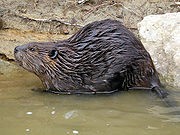
Dipodidae
Caviidae
Heteromyidae

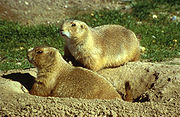
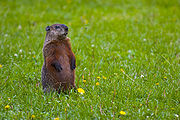
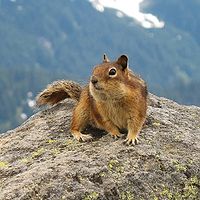
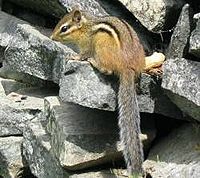
Muroidea
There has been much debate among taxonomist
s about which races of mice and voles should be recognized as full species, and the following list cannot be regarded as definitive.
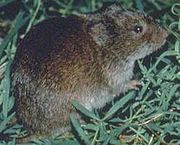

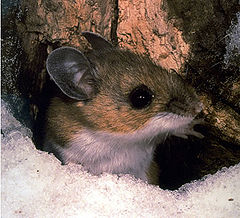
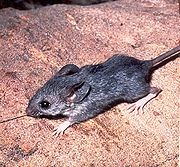
Leporidae
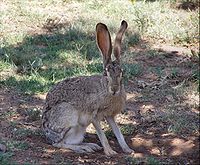
Talpidae

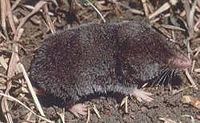
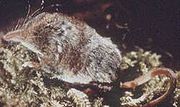

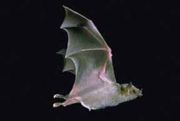
Felidae

Canidae
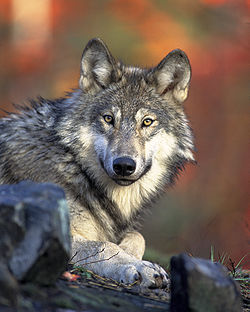
Procyonidae
Mustelidae
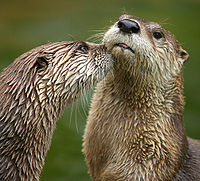

Proboscidea
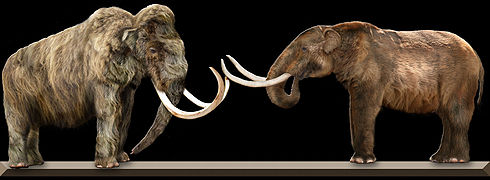
Elephantidae
Equidae
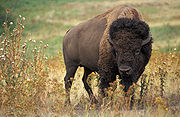
Mammal
Mammals are members of a class of air-breathing vertebrate animals characterised by the possession of endothermy, hair, three middle ear bones, and mammary glands functional in mothers with young...
s currently found in North America
North America
North America is a continent wholly within the Northern Hemisphere and almost wholly within the Western Hemisphere. It is also considered a northern subcontinent of the Americas...
north of Mexico
Mexico
The United Mexican States , commonly known as Mexico , is a federal constitutional republic in North America. It is bordered on the north by the United States; on the south and west by the Pacific Ocean; on the southeast by Guatemala, Belize, and the Caribbean Sea; and on the east by the Gulf of...
, whether resident or as migrant
Animal migration
Animal migration is the relatively long-distance movement of individuals, usually on a seasonal basis. It is a ubiquitous phenomenon, found in all major animal groups, including birds, mammals, fish, reptiles, amphibians, insects, and crustaceans. The trigger for the migration may be local...
s. It does not include species found only in captivity. Mammal species that went extinct since between 10,000 to 13,000 years are included here. Each species is listed, with its binomial name. Most established introduced species occurring across multiple states and provinces are also noted. Some species are identified as indicated below:
- (A) = Accidental occurrence based on one or a few records, and unlikely to occur regularly.
- (E) = ExtinctExtinctionIn biology and ecology, extinction is the end of an organism or of a group of organisms , normally a species. The moment of extinction is generally considered to be the death of the last individual of the species, although the capacity to breed and recover may have been lost before this point...
; any member of the fauna that died out between 13,000 to present times. - (Ex) = Extirpated; no longer occurs in area of interest, but other populations still exist elsewhere.
- (I) = IntroducedIntroduced speciesAn introduced species — or neozoon, alien, exotic, non-indigenous, or non-native species, or simply an introduction, is a species living outside its indigenous or native distributional range, and has arrived in an ecosystem or plant community by human activity, either deliberate or accidental...
population established solely as result of direct or indirect human intervention; synonymous with non-native and non-indigenous.
Dasypodidae
- Nine-banded ArmadilloNine-banded ArmadilloThe nine-banded armadillo , or the nine-banded, long-nosed armadillo, is a species of armadillo found in North, Central, and South America, making it the most widespread of the armadillos...
Dasypus novemcinctus - Beautiful ArmadilloBeautiful ArmadilloDasypus bellus is an extinct armadillo species endemic to North America and South America from the Pleistocene, living from 1.8 mya—11,000 years ago, existing for approximately ....
Dasypus bellus (E)
MegalonychidaeMegalonychidaeMegalonychidae is a group of sloths including the extinct Megalonyx and the living two toed sloths. Megalonychids first appeared in the early Oligocene, about 35 million years ago, in southern Argentina , and spread as far as the Antilles by the early Miocene...

- Jefferson Ground SlothMegalonyxMegalonyx is an extinct genus of giant ground sloths of the family Megalonychidae endemic to North America from the Hemphillian of the Late Miocene through to the Rancholabrean of the Pleistocene, living from ~10.3 Mya—11,000 years ago, existing for approximately .-Taxonomy:The generic name...
Megalonyx jeffersonii (E)
MegatheriidaeMegatheriidaeMegatheriidae is a family of extinct ground sloths that lived from approximately 23 mya—11,000 years ago, existing for approximately .Megatheriids appeared later in the Oligocene, some 30 million years ago, also in South America. The group includes the heavily-built Megatherium and Eremotherium...
- American Giant Ground SlothEremotheriumEremotherium is an extinct genus of actively mobile ground sloth of the family Megatheriidae, endemic to North America and South America during the Pleistocene epoch...
Eremotherium laurillardi (E) - Shasta Ground SlothNothrotheriopsNothrotheriops is a genus of Pleistocene ground sloth found in North and South America. This genus of bear-sized xenarthran was related to the much larger, and far more famous Megatherium, although it has recently been placed in a different family, Nothrotheriidae.-Discovery and species:Fossils of...
Nothrotheriops shastensis (E)
CastoridaeCastoridaeThe family Castoridae contains the two living species of beaver and their fossil relatives. This was once a highly diverse group of rodents, but is now restricted to a single genus, Castor.- Characteristics :...

- American beaverAmerican BeaverThe North American Beaver is the only species of beaver in the Americas, native to North America and introduced to South America. In the United States and Canada, where no other species of beaver occurs, it is usually simply referred to as "beaver"...
Castor canadensis - Giant BeaverGiant BeaverCastoroides ohioensis was a species of giant beaver, huge members of the family Castoridae , endemic to North America during the Pleistocene epoch .-Morphology:...
Castoroides ohioensis (E)
DipodidaeDipodidaeThe Dipodidae, or dipodids, are a family of rodents found across the northern hemisphere. This family includes over 50 species among the 16 genera....
- Woodland jumping mouseWoodland jumping mouseThe Woodland jumping mouse is a species of jumping mouse found in North America. It can hop surprisingly long distances given its small size. The mouse is an extraordinary part of the rodent family. Its scientific name in Latin is Napaeozapus insignis, meaning glen or wooded dell + big or strong...
Napaeozapus insignis - Meadow jumping mouseMeadow jumping mouseThe meadow jumping mouse is the most widely distributed mouse in the subfamily Zapodinae. It may be found from the Atlantic coast, to the Great Plains, as far north as the arctic tree lines in Canada and Alaska, and as far south as Georgia, Alabama, Arizona, and New Mexico.- Description :The...
Zapus hudsonius - Western jumping mouseWestern Jumping MouseThe Western Jumping Mouse , is a species of rodent in the Dipodidae family. It is found in Canada and the United States....
Zapus princeps - Pacific jumping mousePacific Jumping MouseThe Pacific Jumping Mouse is a species of rodent in the family Dipodidae. It is found in Canada and the United States. Its natural habitats are temperate grassland and swamps....
Zapus trinotatus
CaviidaeCaviidaeThe cavy family is a family of rodents native to South America, and including the domestic guinea pig, wild cavies, and the capybara, among other animals...
- American CapybaraNeochoerus pinckneyiNeochoerus pinckneyi was a North American species of capybara. While capybaras originated in South America, formation of the Isthmus of Panama three million years ago allowed some of them to migrate north as part of the Great American Interchange...
Neochoerus pinckneyi (E) - Holmes's capybara Hydrochoerus holmesi (E)
Myocastoridae
- Nutria Myocastor coypus (I)
- Yellow-faced Pocket GopherYellow-faced Pocket GopherThe Yellow-faced Pocket Gopher is a species of pocket gopher that is native to shortgrass prairies in the Southwestern United States and Northern Mexico....
Cratogeomys castanops - Desert Pocket GopherDesert Pocket GopherThe Desert Pocket Gopher is a species of rodent in the family Geomyidae. It is found in the state of Chihuahua in Mexico and in Texas and New Mexico in the United States....
Geomys arenarius - Attwater's Pocket GopherAttwater's Pocket GopherThe Attwater's Pocket Gopher is a species of rodent in the family Geomyidae. It is endemic to the United States....
Geomys attwateri - Baird's Pocket GopherBaird's Pocket GopherBaird’s Pocket Gopher or Louisiana Pocket Gopher is a species of pocket gopher that is native to the Southern United States. In total, there are three almost identical species of eastern pocket gopher; Geomys attwateri, Geomys bursarius, and Geomys breviceps...
Geomys beviceps - Plains Pocket GopherPlains Pocket GopherThe plains pocket gopher is one of thirty-five species of pocket gopher, so named in reference to their externally located, fur-lined cheek pouches. They are burrowing animals, found in grasslands and agricultural land across the Great Plains of North America, from Manitoba to Texas...
Geomys bursarius - Jones's Pocket Gopher Geomys knoxjonesi
- Texas Pocket GopherTexas Pocket GopherThe Texas Pocket Gopher is a species of rodent in the family Geomyidae. It is found in Tamaulipas in Mexico and in Texas in the United States....
Geomys personatus - Southeastern Pocket GopherSoutheastern Pocket GopherThe Southeastern Pocket Gopher, Geomys pinetis, is a species of pocket gopher that is native to the Southeastern United States. It occurs in Alabama, Georgia, and Florida, where it is the only pocket gopher.-Further reading:...
Geomys pinetus - Llano Pocket Gopher Geomys texensis
- Botta's Pocket GopherBotta's pocket gopherBotta's pocket gopher is a pocket gopher native to western North America, from California east to Texas and from southern Utah and Colorado south to Mexico...
Thomomys bottae - Camas Pocket GopherCamas Pocket GopherThe Camas Pocket Gopher is a species of rodent in the family Geomyidae. The species occurs only in the Willamette Valley of northwest Oregon in the United States....
Thomomys bulbivorus - Wyoming Pocket GopherWyoming Pocket GopherThe Wyoming Pocket Gopher is a species of rodent in the Geomyidae family. It is endemic to the United States.This animal is approximately 6.5-7.5 inches long and weighs around one to two ounces. It lives underground in tunnels and burrows that are made possible by its digging abilities. It digs...
Thomomys clusius - Idaho Pocket GopherIdaho Pocket GopherThe Idaho Pocket Gopher is a species of rodent in the family Geomyidae. It is endemic to Idaho, Montana, Utah and Wyoming in the United States. Its natural habitats are temperate forests, dry savanna, and temperate grassland....
Thomomys idahoensis - Mazama Pocket GopherMazama Pocket GopherThe Mazama Pocket Gopher, Thomomys mazama, is a smooth-toothed pocket gopher restricted to the Pacific Northwest. The species ranges from coastal Washington, through Oregon, and into north-central California.-Subspecies:...
Thomomys mazama - Mountain Pocket GopherMountain Pocket GopherThe Mountain Pocket Gopher is a species of rodent in the family Geomyidae. It is endemic to California and Nevada in the United States....
Thomomys monticola - Northern Pocket GopherNorthern Pocket GopherThe Northern Pocket Gopher, Thomomys talpoides, was first discovered by Lewis and Clark on April 9, 1805 at the mouth of the Knife River, North Dakota. These animals are often rich brown or yellowish brown, but also grayish or closely approaching local soil color and have white markings under chin...
Thomomys talpoides - Townsend's Pocket GopherTownsend's Pocket GopherTownsend's Pocket Gopher is a species of rodent in the family Geomyidae. It is endemic to the United States....
Thomomys townsendi - Southern Pocket GopherSouthern Pocket GopherThe Southern Pocket Gopher is a species of rodent in the family Geomyidae. It is found in Mexico and the United States....
Thomomys umbrinus
HeteromyidaeHeteromyidaeThe family of rodents that include kangaroo rats, kangaroo mice and rock pocket mice is the Heteromyidae family. Most heteromyids live in complex burrows within the deserts and grasslands of western North America, though species within the Heteromys and Liomys genera are also found in forests and...
- Mexican Spiny Pocket MouseMexican Spiny Pocket MouseThe Mexican Spiny Pocket Mouse is a species of rodent in the Heteromyidae family. It is found in Mexico and in Texas in the United States....
Liomys irroratus - Ord's Kangaroo RatOrd's Kangaroo RatOrd's Kangaroo Rat, Dipodomys ordii, is a kangaroo rat that is native to Western North America, specifically the Great Plains and the Great Basin with its range extending from extreme southern Canada to central Mexico....
Dipodomys ordii - Gulf Coast Kangaroo RatGulf Coast Kangaroo RatThe Gulf Coast Kangaroo Rat is a species of rodent in the family Heteromyidae found in Mexico and the United States. Its appearance and ecology are very similar to its putative sister-species, Ord's Kangaroo Rat.-References:...
Dipodomys compactus' - Chisel-toothed Kangaroo RatChisel-toothed Kangaroo RatThe Chisel-toothed Kangaroo Rat is a species of rodent in the family Heteromyidae.It is endemic to the United StatesThe Chisel-toothed Kangaroo Rat (Dipodomys microps) is a species of rodent in the family Heteromyidae.It is endemic to the United StatesThe Chisel-toothed Kangaroo Rat (Dipodomys...
Dipodomys microps - Panamint Kangaroo RatPanamint Kangaroo RatThe Panamint Kangaroo Rat, Dipodomys panamintinus, is a species of rodent in the family Heteromyidae. It is endemic to the Mojave Desert in California and Nevada, in the United States. Their tails are 7 inches long. It can swim well...
Dipodomys panamintinus - Stephen's Kangaroo Rat Dipodomys stephensi
- Big-eared Kangaroo Rat Dipodomys elephantinus
- Narrow-faced Kangaroo RatNarrow-faced Kangaroo RatThe Narrow-faced Kangaroo Rat, Dipodomys venustus, is a species of rodent in the family Heteromyidae. It is endemic to California in the United States.-References:...
Dipodomys venustus - Agile Kangaroo RatAgile Kangaroo RatThe Agile Kangaroo Rat, Dipodomys agilis, is a species of rodent in the family Heteromyidae. It is found in Baja California, Mexico and southern California in the United States....
Dipodomys agilis - Heermann's Kangaroo RatHeermann's Kangaroo RatHeermann's Kangaroo Rat, Dipodomys heermanni, is a species of rodent in the family Heteromyidae.Dipodomys heermanni is endemic to California in the United States.-References:...
Dipodomys heermanni - California Kangaroo RatCalifornia Kangaroo RatThe California Kangaroo Rat, Dipodomys californicus. is a species of rodent in the family Heteromyidae.It is endemic to the United States.-References:* Rodent Specialist Group 1996. . Downloaded on 29 July 2007....
Dipodomys californicus - Giant Kangaroo RatGiant Kangaroo RatThe Giant Kangaroo Rat, Dipodomys ingens, is an endangered rodent species endemic to California.-Description:Dipodomys ingens, the Giant Kangaroo Rat, is one of over 20 species of kangaroo rats, which are small members of the rodent family...
Dipodomys ingens - Banner-tailed Kangaroo RatBanner-tailed Kangaroo RatThe Banner-tailed Kangaroo Rat is a species of rodent in the family Heteromyidae.They are found in Mexico and Arizona, New Mexico and Texas in the United States.-References:...
Dipodomys spectabilis - Texas Kangaroo RatTexas Kangaroo RatThe Texas Kangaroo Rat, Dipodomys elator, is native-endemic to Texas where it lives in association with mesquite brush and in areas with firm clay-loam soils. It is a relatively large kangaroo rat that ranges in size from approximately 60 grams to 95 or more. Males and females of this species are...
Dipodomys elator - Merriam's Kangaroo RatMerriam's Kangaroo RatMerriam's Kangaroo Rat, Dipodomys merriami, is a species of rodent in the family Heteromyidae. The species name commemorates Clinton Hart Merriam.-Range:...
Dipodomys merriami - San Jose Island Kangaroo RatSan Jose Island Kangaroo RatThe San Jose Island Kangaroo Rat is a subspecies of rodent in the family Heteromyidae. It is endemic to Mexico, where it is found only on San José Island off the east coast of Baja California Sur. Its natural habitat is hot deserts. It is threatened by habitat degradation by feral goats, and...
Dipodomys insularis - Fresno Kangaroo RatFresno Kangaroo RatThe Fresno Kangaroo Rat or San Joaquin Kangaroo Rat, Dipodomys nitratoides, is a species of rodent in the family Heteromyidae. It is endemic to areas near the San Joaquin Valley of California in the United States. Habitat loss due to agricultural development and urbanization has put this species at...
Dipodomys nitratoides - Desert Kangaroo RatDesert Kangaroo RatThe Desert Kangaroo Rat, Dipodomys deserti, is a rodent species in the family Heteromyidae that is found in desert areas of southwestern North America...
Dipodomys deserti - Dulzura Kangaroo RatDulzura Kangaroo RatThe Dulzura Kangaroo Rat, or San Diego Kangaroo Rat, Dipodomys simulans, is a species of rodent in the family Heteromyidae.The Dulzura Kangaroo Rat occurs in Baja California, Mexico, and in the Colorado Desert and elsewhere in California in the United States....
Dipodomys simulans - Dark Kangaroo MouseDark Kangaroo MouseThe Dark Kangaroo Mouse is a species of rodent in the family Heteromyidae. It is endemic to California, Idaho, Nevada, Oregon and Utah in the United States....
Microdipodops megacephalus - Pale Kangaroo MousePale Kangaroo MouseThe Pale Kangaroo Mouse or Soda Spring Valley Kangaroo Mouse is a species of rodent in the family Heteromyidae. It is endemic to California and Nevada in the United States....
Microdipodops pallidus - White-eared Pocket MouseWhite-eared Pocket MouseThe White-eared Pocket Mouse is a species of rodent in the Heteromyidae family. It is endemic to the San Bernardino Mountains and the Tehachapi Mountains of southern California in the United States....
Perognathus alticola - Arizona Pocket MouseArizona Pocket MouseThe Arizona Pocket Mouse is a rodent native to the Sonoran desert.It is a small mouse with a thinly furred tail that is smooth from base to tip . In color it ranges from tan to orange. It is a nocturnal, burrowing animal...
Perognathus amplus - Olive-backed Pocket MouseOlive-backed Pocket MouseThe Olive-backed Pocket Mouse is a species of rodent in the Heteromyidae family. It is found in the central Great Plains of Canada and the United States....
Perognathus fasciatus - Plains Pocket MousePlains Pocket MouseThe Plains Pocket Mouse They generally live directly underneath Spanish bayonet or prickly pear plants. They are accustomed to sandy soil and eat mostly seeds, large and small grasses and small leaves of plants...
Perognathus flavescens - Silky Pocket MouseSilky Pocket MouseThe Silky Pocket Mouse is a species of rodent in the Heteromyidae family. It is found in Mexico and the United States....
Perognathus flavus - San Joaquin Pocket MouseSan Joaquin Pocket MouseThe San Joaquin Pocket Mouse or Salinas Pocket Mouse is a species of rodent in the family Heteromyidae. It is endemic to California in the United States....
Perognathus inornatus - Little Pocket MouseLittle Pocket MouseThe Little Pocket Mouse is a species of rodent in the Heteromyidae family. It is found in Baja California and Sonora in Mexico and in Arizona, California, Idaho, Nevada, Oregon and Utah in the United States...
Perognathus longimembris - Merriam's Pocket MouseMerriam's Pocket MouseMerriam's Pocket Mouse is a species of rodent in the family Heteromyidae. It is found in Mexico and New Mexico, Oklahoma and Texas in the United States....
Perognathus merriami - Great Basin Pocket MouseGreat Basin Pocket MouseThe Great Basin Pocket Mouse is a species of rodent in the Heteromyidae family. It is found in British Columbia in Canada and the western United States.-Taxonomy:...
Perognathus parvus - Bailey's Pocket MouseBailey's Pocket MouseBailey's Pocket Mouse is a species of rodent in the family Heteromyidae. It is found in Mexico and in California, Arizona and New Mexico in the United States.-References:...
Chaetodipus baileyi - California Pocket MouseCalifornia Pocket MouseThe California Pocket Mouse is a species of rodent in the Heteromyidae family.It is found in Baja California in Mexico and in California in the United States.-References:...
Chaetodipus californicus - Chihuahuan Desert Pocket Mouse Chaetodipus eremicus
- San Diego Pocket MouseSan Diego Pocket MouseThe San Diego Pocket Mouse is a species of rodent in the family Heteromyidae. It is found in Baja California in Mexico and California in the United States.-References:...
Chaetodipus fallax - Long-tailed Pocket MouseLong-tailed Pocket MouseThe Long-tailed Pocket Mouse is a species of rodent in the family Heteromyidae.It is found in Arizona, California, Nevada and Utah in the United States and Baja California in Mexico.-References:...
Chaetodipus formosus - Hispid Pocket MouseHispid pocket mouseThe hispid pocket mouse is a large pocket mouse native to the Great Plains region of North America. It is a member of the genus Chaetodipus.-Distribution:...
Chaetodipus hispidus - Rock Pocket MouseRock pocket mouseThe rock pocket mouse, C. intermedius, is one of 19 species of pocket mice in the genus Chaetodipus....
Chaetodipus intermedius - Nelson's Pocket MouseNelson's Pocket MouseNelson's Pocket Mouse is a species of rodent in the family Heteromyidae. It is found in Mexico and in New Mexico and Texas in United States.-References:...
Chaetodipus nelsoni - Desert Pocket MouseDesert pocket mouseThe desert pocket mouse is a North American species of heteromyid rodent found in the southwestern United States and Mexico. True to its common name, the desert pocket mouse prefers sandy, sparsely vegetated desert. Its primary diet is seeds, making it a granivore...
Chaetodipus penicillatus - Spiny Pocket MouseSpiny Pocket MouseThe Spiny Pocket Mouse is a species of rodent in the family Heteromyidae. It is found in Baja California in Mexico and in Arizona, California and Nevada in the United States.-References:...
Chaetodipus spinatus
Sciuridae





- Eastern Gray SquirrelEastern Gray SquirrelThe eastern gray squirrel is a tree squirrel in the genus Sciurus native to the eastern and midwestern United States, and to the southerly portions of the eastern provinces of Canada...
Sciurus carolinensis - Eastern Fox Squirrel Sciurus niger
- Mexican Fox SquirrelMexican Fox SquirrelThe Mexican Fox Squirrel is a species of tree squirrel found throughout the Sierra Madre Occidental as far south as Jalisco, Mexico, northward into the United States only in the Chiricahua Mountains of southeastern Arizona...
Sciurus nayaritensis - Arizona Gray SquirrelArizona Gray SquirrelThe Arizona gray squirrel is a tree squirrel in the genus Sciurus endemic to the canyons and valleys surrounded by deciduous and mixed forests in eastern Arizona and northern Mexico....
Sciurus arizonensis - Western Gray SquirrelWestern Gray SquirrelThe Western Gray Squirrel is an arboreal rodent found along the western coast of the United States and Canada.In some places, this species has also been known as the Silver-gray Squirrel, the California Gray Squirrel, the Oregon Gray Squirrel, the Columbian Gray Squirrel and the Banner-tail...
Sciurus griseus - Red SquirrelAmerican Red SquirrelThe American Red Squirrel is one of three species of tree squirrel currently classified in the genus Tamiasciurus and known as pine squirrels...
Tamiasciurus hudsonicus - Douglas' Squirrel Tamiasciurus douglasii
- Abert's SquirrelAbert's SquirrelAbert's squirrel is a tree squirrel in the genus Sciurus endemic to the Rocky Mountains from United States to Mexico, with concentrations found in Arizona, The Grand Canyon, New Mexico, and southwestern Colorado.-Etymology:The Abert's squirrel is named after Colonel John James Abert, an American...
Sciurus alberti - Northern Flying SquirrelNorthern Flying SquirrelThe Northern flying squirrel is one of two species of the genus Glaucomys, the only flying squirrels found in North America . Unlike most members of their family, flying squirrels are strictly nocturnal...
Glaucomys sabrinus - Southern Flying SquirrelSouthern Flying SquirrelThe Southern Flying Squirrel is one of two species of the genus Glaucomys, the only flying squirrels found in North America . It is found in deciduous and mixed woods in the eastern half of North America, from southeastern Canada, to Florida, USA...
Glaucomys volans - Harris's Antelope SquirrelHarris's Antelope SquirrelHarris's antelope squirrel is a species of rodent in the Sciuridae family.It is found in Mexico and the United States.-References:...
Ammospermophilus harrisii - San Joaquin Antelope SquirrelSan Joaquin Antelope SquirrelThe San Joaquin antelope squirrel or Nelson's antelope squirrel.Ammospermophilus nelsoni, is a species of antelope squirrel, in the San Joaquin Valley of the U.S. state of California.-Distribution and habitat:...
Ammospermophilus nelsoni - White-tailed Antelope SquirrelWhite-tailed Antelope SquirrelThe white-tailed antelope squirrel is a diurnal species of ground squirrel found in arid regions of the southwestern United States and northern Mexico...
Ammospermophilus leucurus - Texas Antelope SquirrelTexas Antelope SquirrelThe Texas antelope squirrel is a species of rodent in the Sciuridae family.It is found in Mexico and the United States.-References:...
Ammospermophilus interpres - Gunnison's Prairie DogGunnison's Prairie DogGunnison's prairie dog is one of five species of the prairie dog. This species belongs to the squirrel family of rodents, and are predominantly related to the North American and Eurasian ground squirrels...
Cynomys gunnisoni - White-tailed Prairie DogWhite-tailed Prairie DogThe white-tailed prairie dog is found in western Wyoming and western Colorado with small areas in eastern Utah and southern Montana. The largest populations are in Wyoming where they are known colloquially as "chiselers". This prairie dog species lives between 5,000 and 10,000 feet, generally a...
Cynomys leucurus - Black-tailed Prairie DogBlack-tailed Prairie DogThe black-tailed prairie dog , is a rodent of the family Sciuridae found in the Great Plains of North America from about the USA-Canada border to the USA-Mexico border. Unlike some other prairie dogs, these animals do not truly hibernate. The black-tailed prairie dog can be seen aboveground in...
Cynomys ludovicianus - Utah Prairie DogUtah Prairie DogThe Utah prairie dog is the smallest species of prairie dog, a member of the squirrel family of rodents native to the south central steppes of the US state of Utah....
Cynomys parvidens - Alaska MarmotAlaska MarmotThe Alaska Marmot , also known as the Brooks Range Marmot or the Browers , is a species of rodent in the family Sciuridae. It is found in the scree slopes of the Brooks Range, Alaska, which provide some protection from predators. They eat grass, flowering plants, berries, roots, moss, and lichen...
Marmota broweri - Hoary MarmotHoary MarmotThe hoary marmot is a species of marmot that inhabits the mountains of northwest North America. Hoary marmots live near the tree line on slopes with grasses and forbs to eat and rocky areas for cover....
Marmota caligata - Yellow-bellied MarmotYellow-bellied MarmotThe yellow-bellied marmot , also known as the rock chuck, is a ground squirrel in the marmot genus.-Description:...
Marmota flaviventris - Woodchuck Marmota monax
- Olympic MarmotOlympic MarmotThe Olympic marmot, Marmota olympus, is a marmot . They are found in alpine and subalpine meadows and talus slopes on the Olympic Peninsula in the U.S. state of Washington, and are close relatives of the hoary marmot.Like most marmots, they are gregarious burrowing animals...
Marmota olympus - Vancouver Marmot Marmota vancouverensis
- Uinta Ground SquirrelUinta Ground SquirrelThe Uinta ground squirrel , commonly called a Potgut in northern Utah, is a native of the northern Rocky Mountains and surrounding foothills of the United States including Idaho, Montana, Utah, and Wyoming...
Spermophilus armatus - California Ground SquirrelCalifornia Ground SquirrelThe California ground squirrel , is a common and easily observed ground squirrel of the western United States and the Baja California peninsula; it is common in Oregon and California and its range has relatively recently extended into Washington and northwestern Nevada...
Spermophilus beecheyi - Belding's Ground SquirrelBelding's Ground SquirrelBelding's ground squirrel , also called pot gut, sage rat or picket-pin, is a squirrel that lives on mountains in the western United States. In California, it often is found at 6,500–11,800 feet in meadows between Lake Tahoe and Kings Canyon...
Spermophilus beldingi - Idaho Ground SquirrelIdaho Ground SquirrelThe Idaho ground squirrel is a species of the largest genus of ground squirrels. There are two subspecies, both in Idaho. They are also known as Idaho Spotted Ground Squirrel.-Description:...
Spermophilus brunneus - Merriam's Ground SquirrelMerriam's Ground SquirrelMerriam's ground squirrel is a species of rodent in the family Sciuridae. It occurs in the states of Idaho, Nevada, and Oregon in the United States.-Description:...
Spermophilus canus - Columbian Ground SquirrelColumbian Ground SquirrelThe Columbian ground squirrel is a species of rodent in the Sciuridae family. It is found in Canada and the United States....
Spermophilus columbianus - Wyoming Ground SquirrelWyoming Ground SquirrelThe Wyoming ground squirrel is a species of rodent in the Sciuridae family. It is endemic to the United States....
Spermophilus elegans - Franklin's ground squirrelFranklin's ground squirrelFranklin's ground squirrel is a species native to tallgrass American prairie, from Canada to the northcentral United States.The species hibernates from early fall to spring, and bears a litter of 6–8 pups at a time...
Spermophilus franklinii - Golden-mantled Ground SquirrelGolden-mantled Ground SquirrelThe golden-mantled ground squirrel, Callospermophilus lateralis, is a type of ground squirrel found in mountainous areas of western North America. It eats seeds, nuts, berries, insects, and underground fungi. It is preyed upon by hawks, jays, weasels, foxes, bobcats, and coyotes. A typical adult...
Spermophilus lateralis - Mexican Ground SquirrelMexican Ground SquirrelThe Mexican ground squirrel is a species of rodent in the family Sciuridae. It is found in Mexico and the United States....
Spermophilus mexicanus - Mohave Ground SquirrelMohave Ground SquirrelThe Mohave ground squirrel is a species of ground squirrel found only in the Mojave Desert in California. The squirrel was discovered in 1886 by Frank Stephens of San Diego The Mohave ground squirrel (Xerospermophilus mohavensis) is a species of ground squirrel found only in the Mojave Desert in...
Spermophilus mohavensis - Piute Ground SquirrelPiute Ground SquirrelThe Piute ground squirrel is a species of rodent in the family Sciuridae. It is endemic to the United States....
Spermophilus mollis - Arctic Ground SquirrelArctic Ground SquirrelThe Arctic ground squirrel is a species of ground squirrel native to the Arctic.-Subspecies:Listed alphabetically.*S. p. ablusus Osgood, 1903...
Spermophilus parryii - Richardson's Ground SquirrelRichardson's Ground SquirrelRichardson's ground squirrel , or the flickertail, is a North American ground squirrel in the genus Urocitellus...
Spermophilus richardsonii - Cascade Golden-mantled Ground SquirrelCascade Golden-mantled Ground SquirrelThe Cascade golden-mantled ground squirrel is a species of rodent in the Sciuridae family. It is found in the Cascade Mountains in the province of British Columbia, Canada and the state of Washington, United States....
Spermophilus saturatus - Spotted Ground SquirrelSpotted Ground SquirrelThe spotted ground squirrel is a species of rodent in the Sciuridae family. It is found in Mexico and the United States....
Spermophilus spilosoma - Round-tailed Ground SquirrelRound-tailed Ground SquirrelThe round-tailed ground squirrel , known as "Ardillón cola redonda" in Spanish, live in the desert of the Southwestern United States and adjacent Mexico. They are called "ground squirrels" because they burrow in loose soil, often under mesquite trees and creosote bushes.-Characteristics:Most...
Spermophilus tereticaudus - Townsend's Ground SquirrelTownsend's Ground SquirrelThe Townsend's ground squirrel is a species of rodent in the Sciuridae family. It is found in high desert shrublands in several areas of the United States.-Distribution:...
Spermophilus townsendii - Thirteen-lined Ground SquirrelThirteen-lined ground squirrelThe thirteen-lined ground squirrel , also known as the striped gopher, leopard ground squirrel, squinney, and as the leopard-spermophile in Audubon’s day, is a ground squirrel....
Spermophilus tridecemlineatus - Rock SquirrelRock SquirrelThe rock squirrel is a species of rodent in the family Sciuridae. It is found in Mexico and the United States. It is 43–53 cm long.-External links:**...
Spermophilus variegatus - Washington Ground SquirrelWashington Ground SquirrelThe Washington ground squirrel is a squirrel found in the Pacific Northwest United States, in the states of Washington and Oregon. The species is listed as endangered in Oregon and is a candidate for endangered species listing in the United States, but is not currently listed...
Spermophilus washingtoni - Alpine ChipmunkAlpine ChipmunkThe alpine chipmunk is a species of chipmunk native to the high elevations of the Sierra Nevada of California. They have been observed at altitudes from around 2,300 meters to 3,900 meters , though they rarely occur below 2,500 meters .- Description :They have a...
Tamias alpinus - Yellow Pine Chipmunk Tamias amoenus
- Gray-footed ChipmunkGray-footed ChipmunkThe gray-footed chipmunk is a species of rodent in the family Sciuridae. It is endemic to New Mexico and Texas in the United States. Its natural habitat is temperate forests....
Tamias canipes - Gray-collared ChipmunkGray-collared ChipmunkThe gray-collared chipmunk is a species of rodent in the family Sciuridae. It is endemic to Arizona and New Mexico in the United States....
Tamias cinereicollis - Cliff ChipmunkCliff ChipmunkThe cliff chipmunk is a small, bushy-tailed squirrel that typically lives along cliff walls or boulder fields bordering Pinyon-juniper woodlands in the Western United States and Mexico. Cliff chipmunks are very agile, and can often be seen scaling steep cliff walls. Cliff chipmunks do not amass...
Tamias dorsalis - Merriam's ChipmunkMerriam's ChipmunkMerriam's chipmunk is a species of rodent in the Sciuridae family. It is found in central and southern California. in the United States and a small area in northern Baja California, Mexico....
Tamias merriami - Least ChipmunkLeast ChipmunkThe least chipmunk is the smallest chipmunk in North America. It is also the most widespread species of chipmunk in North America occurring across north-central and western United States and from British Columbia and southern Yukon to western Quebec in Canada...
Tamias minimus - California ChipmunkCalifornia ChipmunkThe California chipmunk is a species of rodent in the squirrel family Sciuridae. It is found in Baja California, Mexico and in southern California in the United States....
Tamias obscurus - Yellow-cheeked ChipmunkYellow-cheeked ChipmunkThe yellow-cheeked chipmunk is a species of rodent in the squirrel family Sciuridae. It is endemic to the areas near the coast of northern California in the United States....
Tamias ochrogenys - Palmer's ChipmunkPalmer's ChipmunkPalmer's chipmunk is a species of rodent in the family Sciuridae. It is only found in the Spring Mountains of Clark County, Nevada in the United States. Its natural habitat is temperate forests. It is threatened by habitat loss....
Tamias palmeri - Panamint ChipmunkPanamint ChipmunkThe Panamint chipmunk is a species of rodent in the squirrel family Sciuridae. It is endemic to desert mountain areas of southeast California and southwest Nevada in the United States....
Tamias panamintinus - Long-eared ChipmunkLong-eared ChipmunkThe long-eared chipmunk , also called the Sacramento chipmunk or the four-banded chipmunk, is a species of rodent in the squirrel family Sciuridae. It is endemic to the central and northern Sierra Nevada Mountains of California and Nevada in the United States...
Tamias quadrimaculatus - Colorado ChipmunkColorado ChipmunkThe Colorado chipmunk is a species of rodent in the squirrel family Sciuridae. It is endemic to Colorado, Utah, Arizona and New Mexico in the United States.-References:...
Tamias quadrivittatus - Red-tailed ChipmunkRed-tailed ChipmunkThe red-tailed chipmunk is a species of rodent in the Sciuridae family. It is found in Alberta and British Columbia in Canada and Montana, Idaho and Washington in the United States....
Tamias ruficaudus - Hopi ChipmunkHopi chipmunkThe Hopi chipmunk is a small chipmunk found in Colorado, Utah and Arizona in the southwestern United States. It was previously grouped with the Colorado Chipmunk, T. quadrivittatus....
Tamias rufus - Allen's ChipmunkAllen's ChipmunkAllen's chipmunk is a species of rodent in the family Sciuridae. It is endemic to the United States. The main populations are found in California, specifically the humid forests of the mountainous areas of Northern California including the Northern Coastal Range of California, the Trinity Alps,...
Tamias senex - Siskiyou ChipmunkSiskiyou ChipmunkThe Siskiyou chipmunk is a species of rodent in the family Sciuridae. It is endemic to northern California and central Oregon in the United States....
Tamias siskiyou - Sonoma ChipmunkSonoma ChipmunkThe Sonoma chipmunk is a species of rodent in the squirrel family Sciuridae. It is endemic to northwestern California in the United States....
Tamias sonomae - Lodgepole ChipmunkLodgepole ChipmunkThe Lodgepole chipmunk is a species of rodent in the family Sciuridae. It is found in the U.S. state of California at elevations from .-External links:*...
Tamias speciosus - Eastern ChipmunkEastern ChipmunkThe eastern chipmunk is a small squirrel-like rodent found in eastern North America, the sole living member of the chipmunk genus and subgenus Tamias....
Tamias striatus - Townsend's ChipmunkTownsend's ChipmunkTownsend's chipmunk is a species of rodent in the squirrel family Sciuridae. It lives in the forests of the Pacific Northwest of North America, from British Columbia through western Washington and Oregon. A large chipmunk, adults can be from nose to tail...
Tamias townsendii - Uinta ChipmunkUinta ChipmunkThe Uinta chipmunk, Neotamias umbrinus, is a species of Chipmunk, a rodent in the family Sciuridae. It is endemic to the United States.-Habitat:...
Tamias umbrinus
MuroideaMuroideaMuroidea is a large superfamily of rodents. It includes hamsters, gerbils, true mice and rats, and many other relatives. They occupy a vast variety of habitats on every continent except Antarctica. Some authorities have placed all members of this group into a single family, Muridae, due to...
There has been much debate among taxonomistTaxonomy
Taxonomy is the science of identifying and naming species, and arranging them into a classification. The field of taxonomy, sometimes referred to as "biological taxonomy", revolves around the description and use of taxonomic units, known as taxa...
s about which races of mice and voles should be recognized as full species, and the following list cannot be regarded as definitive.




- Insular VoleInsular VoleThe Insular Vole or St. Matthew Island Vole is a species of rodent in the family Cricetidae. It occurs only on St. Matthew Island and the adjacent Hall Island, in Alaska. On these Bering Sea islands, Insular Voles live in damp lowland areas, on the lower slopes of mountains, and on rye...
Microtus abbreviatus - Beach VoleBeach VoleThe Beach Vole is a species of rodent in the family Cricetidae. It is found only in the United States, and its natural habitat is temperate grassland....
Microtus breweri - California VoleCalifornia VoleThe California vole is a type of vole which lives throughout much of California and part of southwestern Oregon. It is also known as the California meadow mouse. It averages in length although this length varies greatly between subspecies.-Description:The California vole is a medium sized vole,...
Microtus californicus - Gray-tailed VoleGray-tailed VoleThe Gray-tailed vole is a common small mammal that inhabits grasslands in the Willamette Valley of western Oregon . Gray tailed voles are polygamous: females are territorial, males have large home ranges that overlap those of several females, and juvenile emigration is male biased...
Microtus canicaudis - Rock VoleRock VoleThe Rock Vole is a medium-sized vole found in eastern North America. It is also called the Yellow-nosed Vole....
Microtus chrotorrhinus - Long-tailed VoleLong-tailed VoleThe Long-tailed Vole is a small vole found in western North America. The Coronation Island Vole, once considered to be a separate species, is now believed to be a subspecies....
Microtus longicaudus - Mexican VoleMexican VoleThe Mexican Vole is a species of rodent in the family Cricetidae. It is found in Mexico and the United States.-References:...
Microtus mexicanus - Mogollon Vole Microtus mogollonensis
- Singing VoleSinging VoleThe singing vole, Microtus miurus, is a medium-sized vole found in northwestern North America, including Alaska and northwestern Canada.-Physical characteristics:...
Microtus miurus - Montane VoleMontane VoleThe Montane Vole is a species of rodent in the family Cricetidae.It is found in the western United States and British Columbia in Canada.-References:...
Microtus montanus - Prairie VolePrairie VoleThe Prairie Vole is a small vole found in central North America. The vole has long, coarse grayish-brown fur on the upper portion of the body and yellowish fur on the lower portion of the body...
Microtus ochrogaster - Tundra VoleTundra VoleThe Tundra Vole or Root Vole, Microtus oeconomus, is a medium-sized vole found in Northern and Central Europe, Asia, and northwestern North America, including Alaska and northwestern Canada...
Microtus oeconomus - Creeping VoleCreeping VoleThe Creeping Vole is a species of rodent in the family Cricetidae.It is found in British Columbia in Canada and in California, Oregon and Washington in the United States.-References:...
Microtus oregoni - Meadow VoleMeadow VoleThe Meadow Vole , sometimes called the Field Mouse or Meadow Mouse, is a North American vole found across Canada, Alaska and the northern United States. Its range extends further south along the Atlantic coast. One subspecies, the Florida Salt Marsh Vole , is found in Florida, and is classified as...
Microtus pennsylvanicus - Woodland VoleWoodland VoleThe Woodland Vole, Microtus pinetorum, is a small vole found in eastern North America. It is also known as the Pine Vole.-Description:...
Microtus pinetorum - Water VoleWater Vole (North America)The Water Vole, Microtus richardsoni, is the largest North American vole. It is found in the northwestern United States and southern parts of western Canada...
Microtus richardsoni - Townsend's VoleTownsend's VoleTownsend's Vole is a species of rodent in the family Cricetidae.It is found in British Columbia in Canada and in Washington and Oregon in the United States.Its natural habitat is temperate grassland.-References:...
Microtus townsendii - Taiga VoleTaiga VoleThe Taiga Vole, Microtus xanthognathus, is a large vole found in northwestern North America, including Alaska and northwestern Canada. It is also sometimes called the Yellow-cheeked Vole or Chestnut-cheeked Vole....
Microtus xanthognathus - Sagebrush VoleSagebrush VoleThe Sagebrush Vole is a tiny vole found in western North America. This is the only member of genus Lemmiscus....
Lemmiscus curtatus - MuskratMuskratThe muskrat , the only species in genus Ondatra, is a medium-sized semi-aquatic rodent native to North America, and introduced in parts of Europe, Asia, and South America. The muskrat is found in wetlands and is a very successful animal over a wide range of climates and habitats...
Ondatra zibethicus' - White-footed VoleWhite-footed VoleThe White-footed Vole is a species of rodent in the family Cricetidae. It is found only in the United States. Its natural habitat is temperate forests.-Source:...
Arborimus albipes - Red Tree VoleRed Tree VoleThe Red Tree Vole is a species of rodent in the family Cricetidae.It is found only in the United States. Red tree voles are found in the upper branches of arboreal conifers throughout Northern California and Western Oregon. Their preference and food source is thought to be Douglas Fir and Redwood...
Arborimus longicaudus - Sonoma Tree Vole Arborimus pomo
- Western Heather VoleWestern Heather VoleThe Western Heather Vole, Phenacomys intermedius, is a small vole found in western North America. Until recently, the Eastern Heather Vole, Phenacomys ungava, was considered to be a subspecies....
Phenacomys intermedius - Eastern Heather VoleEastern Heather VoleThe Eastern Heather Vole, Phenacomys ungava, is a small North American vole. Until recently, this species was considered to belong to the same species as the Western Heather Vole, Phenacomys intermedius. It is also called the Ungava Vole....
Phenacomys ungava - Western Red-backed VoleWestern Red-Backed VoleThe Western Red-Backed Vole is a species of vole in the family Cricetidae. It is found in California and Oregon in the United States and lives mainly in coniferous forest...
Myodes californicus - Southern Red-backed VoleSouthern Red-backed VoleThe Southern Red-backed Vole or Gapper's Red-backed Vole is a small slender vole found in Canada and the northern United States...
Myodes gapperi - Northern Red-backed VoleNorthern Red-backed VoleThe northern red-backed vole, Myodes rutilus, is a small slender vole found in Alaska, northern Canada, Scandinavia and northern Russia.-Description:...
Myodes rutilus - Northern Bog LemmingNorthern Bog LemmingThe Northern Bog Lemming, Synaptomys borealis is a small North American lemming. This is one of two species in genus Synaptomys, the other being the Southern Bog Lemming....
Synaptomys borealis - Southern Bog LemmingSouthern Bog LemmingThe Southern Bog Lemming, Synaptomys cooperi is a small North American lemming. Its range overlaps with the other species in genus Synaptomys, the Northern Bog Lemming, in southeastern Canada but extends further south....
Synaptomys cooperi - Brown LemmingNorth American Brown LemmingThe North American brown lemming, Lemmus trimucronatus, is a small North American lemming. Originally called the Siberian Brown Lemming Lemmus sibiricus it was later decided that they formed two distinct species....
Lemmus trimucronatus - Round-tailed MuskratRound-Tailed MuskratThe Round-tailed Muskrat is a species of rodent in the family Cricetidae, sometimes called the Florida water rat. It is the only species in the genus Neofiber....
Neofiber alleni - Northern Collared LemmingNorthern Collared LemmingThe Northern Collared Lemming , sometimes called the Peary Land Collared Lemming in Canada, is a small North American lemming. At one time, it was considered to be a subspecies of the Arctic Lemming...
Dicrostonyx groenlandicus - Ungava Collared LemmingUngava Collared LemmingThe Ungava Collared Lemming or Labrador Collared Lemming, Dicrostonyx hudsonius is a small North American lemming.They have short chunky bodies covered with brownish-grey fur with a thin dark stripe along their back and a yellow line along their sides. They have small ears, short legs and a very...
Dicrostonyx hudsonius - Richardson's Collared LemmingRichardson's Collared LemmingThe Richardson's Collared Lemming, Dicrostonyx richardsoni is a small North American lemming. At one time, they were considered to be a subspecies of the Arctic Lemming, Dicrostonyx torquatus...
Dicrostonyx richardsoni - White-throated WoodratWhite-Throated WoodratThe white-throated woodrat is a species of rodent in the family Cricetidae. It is found from central Mexico north to Utah and Colorado in the United States. It is primarily a western species in the United States, extending from central Texas west to southeastern California...
Neotoma albigula - Bushy-tailed WoodratBushy-tailed WoodratThe Bushy-tailed Woodrat, Packrat, or Woodrat is a species of rodent in the family Cricetidae.It is found in Canada and the United States....
Neotoma cinerea - Arizona WoodratArizona WoodratThe Arizona Woodrat is a species of rodent in the family Cricetidae.It is found in Mexico and United States.-References:...
Neotoma devia - Eastern WoodratFlorida WoodratThe Eastern Woodrat ', is a species of pack rat that is native to the central and eastern United States. Its range extends from the latitude of southeastern New York south to the Gulf of Mexico...
Neotoma floridana - Dusky-footed WoodratDusky-Footed WoodratThe Dusky-footed Woodrat is a species of nocturnal rodent in the family Cricetidae. They are commonly called "packrats" or "trade rats" and build large, domed dens that can reach several feet in height. Coyotes and other predators will attempt to prey on these rodents by laying waste to the dens,...
Neotoma fuscipes - Desert WoodratDesert WoodratThe Desert Woodrat is a small species of pack rat native to desert regions of western North America, ranging from southeastern Oregon and southwestern Idaho, south to California in the U.S., and Baja California and extreme northwestern Sonora in Mexico.This pack rat is 8.5 to 15 inches long...
Neotoma lepida - Allegheny Woodrat Neotoma magister
- Mexican WoodratMexican WoodratThe Mexican Woodrat is a medium-sized rat occurring in the United States from Utah and Colorado south through New Mexico and parts of Arizona and Trans-Pecos Texas. Its range continues south in the highlands to Honduras...
Neotoma mexicana - Southern Plains WoodratSouthern Plains WoodratThe Southern Plains Woodrat is a species of rodent in the family Cricetidae. It is found in northwest Mexico and in Colorado, Kansas, New Mexico, Oklahoma and Texas in the United States.-References:...
Neotoma micropus - Stephen's WoodratStephen's WoodratStephen's Woodrat is a species of rodent in the family Cricetidae.It is found in Arizona, New Mexico and Utah in the United States.-References:...
Neotoma stephensi - Golden Mouse Ochrotomys nuttalli
- California MouseCalifornia MouseThe California Mouse is a species of rodent in the family Cricetidae. It is the only species in the Peromyscus californicus species group. It is found in north-western Mexico and central to southern California...
Peromyscus californicus - Cactus MouseCactus MouseThe Cactus Mouse is a species of rodent in the family Cricetidae.It is found in Mexico and the United States....
Peromyscus eremicus - Mesquite MouseMesquite MouseThe Mesquite Mouse is a species of rodent in the family Cricetidae.It is found in Mexico and in Arizona in the United States.-References:...
Peromyscus merriami - Canyon Mouse Peromyscus crinitis
- Deer MousePeromyscus maniculatusPeromyscus maniculatus is a rodent native to North America. It is most commonly called the Deer Mouse, although that name is common to most species of Peromyscus and is fairly widespread across the continent, with the major exception being the southeast United States and the far north.Like other...
Peromyscus maniculatus - Oldfield MouseOldfield MouseThe oldfield mouse or beach mouse is a nocturnal species of rodent in the family Cricetidae. It is found in the southeastern United States on sandy beaches, in corn and cotton fields, and in hedge rows and open timber tracts...
Peromyscus polionotus - White-footed MouseWhite-footed mouseWhite-footed Mouse is a rodent native to North America. It ranges from Ontario, Quebec, Labrador and the Maritime Provinces to the southwest USA and Mexico. It is also known as the Woodmouse, particularly in Texas.Adults are in length, not counting the tail, which can add another . A young adult...
Peromyscus leucopus - Cotton MouseCotton MouseThe Cotton Mouse is a species of rodent in the family Cricetidae.It is found in the woodlands of the south-eastern states of the United States. Adults are about 7-8 inches, and have an appearance very similar to the white footed mouse. The cotton mouse is larger in size and has a longer...
Peromyscus gossypinus - Brush MouseBrush MouseThe brush mouse is a species of rodent in the family Cricetidae. It is found in mountainous areas of Mexico and the western United States at altitudes over .-Description:...
Peromyscus boylii - Texas MouseTexas MouseThe Texas Mouse is a species of rodent in the family Cricetidae.It is found in Arkansas, Kansas, Missouri, Oklahoma and Texas in the United States.-References:...
Peromyscus attwateri - White-ankled MouseWhite-Ankled MouseThe White-ankled Mouse is a species of rodent in the family Cricetidae.It is found in Mexico and in New Mexico, Oklahoma and Texas in the United States.-References:...
Peromyscus pectoralis - Pinyon MousePinyon MousePeromyscus truei or the pinyon mouse, is native to the southwestern United States. These medium sized mice are often distinguished by their relatively large ears...
Peromyscus truei - Osgood's MouseOsgood's MouseOsgood's Mouse is a species of rodent in the family Cricetidae.It is found only in Mexico. Its name references Wilfred Hudson Osgood.-References:* Baillie, J. 1996. . Downloaded on 19 July 2007....
Peromyscus gratus - Northwestern Deer MouseNorthwestern Deer MouseThe Northwestern Deer Mouse or Keen's Mouse is a species of rodent in the family Cricetidae. It is found in British Columbia in Canada and in Alaska and Washington in the United States. It was named after the Rev. John Henry Keen in 1894.-References:*Musser, G. G. and M. D. Carleton. 2005....
Peromyscus keeni - Northern Rock MouseNorthern Rock MouseThe Northern Rock Mouse is a species of rodent in the family Cricetidae.It is found in Mexico and the United States.-References:...
Peromyscus nasutus - Fulvous Harvest MouseFulvous Harvest MouseThe Fulvous Harvest Mouse is a species of rodent in the family Cricetidae.It is found in El Salvador, Guatemala, Honduras, Mexico, Nicaragua, and the United States.-References:...
Reithrodontomys fulvescens - Eastern Harvest MouseEastern Harvest MouseThe Eastern Harvest Mouse is a species of rodent in the family Cricetidae.It is found only in the United States....
Reithrodontomys humulis - Western Harvest MouseWestern harvest mouseThe Western Harvest Mouse is a small neotomine mouse native to southwest British Columbia, most of the western United States extending continuously to west Texas, northeast Arkansas, northwest Indiana, southwest Wisconsin, the interior of Mexico to Oaxaca...
Reithrodontomys megalotis - Plains Harvest MousePlains Harvest MouseThe Plains Harvest Mouse is a species of rodent in the family Cricetidae.It is found in northern Mexico and the central United States.-References:...
Reithrodontomys montanus - Salt Marsh Harvest MouseSalt Marsh Harvest MouseThe Salt Marsh Harvest Mouse , also known as the Red-bellied Harvest Mouse and some times called by Saltmarsh Harvest Mouse, is an endangered rodent endemic to the San Francisco Bay Area salt marshes in California. There are two distinct subspecies, both endangered and listed together on federal...
Reithrodontomys raviventris - Mearn's grasshopper mouseChihuahuan Grasshopper MouseThe Chihuahuan Grasshopper Mouse or Mearns's Grasshopper Mouse is a grasshopper mouse found in southwestern New Mexico, west Texas, and north-central Mexico. They are similar to Onychomys torridus, but differ in karyotype and size. The Chihuahuan Grasshopper Mouse is smaller.They are found in...
Onychomys arenicola - Northern grasshopper mouse Onychomys leucogaster
- Southern grasshopper mouseSouthern Grasshopper MouseThe Southern Grasshopper Mouse is a species of rodent in the family Cricetidae.It is found in Mexico and in Arizona, California, Nevada, New Mexico and Utah in the United States.-References:...
Onychomys torridus - Florida MouseFlorida MouseThe Florida mouse is a species of rodent in the family Cricetidae. It is the only species in the genus Podomys, which is the only mammal genus endemic to Florida...
Podomys floridanus - Hispid Cotton RatHispid Cotton RatThe Hispid Cotton Rat is a rodent species long thought to occur in parts of South America, Central America, and southern North America. However, recent taxonomic revisions, based on mitochondrial DNA sequence data, have split this widely distributed species into three separate species. Carroll et...
Sigmodon hispidus - Yellow-nosed Cotton RatYellow-Nosed Cotton RatThe yellow-nosed cotton rat is a species of rodent in the family Cricetidae. Its range extends from the eastern side of the Sierra Madre Occidental to central Durango and western Coahuila in Mexico, and from Arizona to New Mexico and scattered desert ranges of the Mesa del Norte in Trans-Pecos...
Sigmodon ochrognathus - Arizona Cotton RatArizona Cotton RatThe Arizona cotton rat or Colorado River cotton rat is a species of rodent in the family Cricetidae. It is found in Mexico and the United States.-Description:...
Sigmodon arizonae - Tawny-bellied Cotton RatTawny-Bellied Cotton RatThe Tawny-bellied Cotton Rat is a species of rodent in the family Cricetidae.It is found in Mexico and in Arizona and New Mexico in the United States.-References:...
Sigmodon fulviventer - Coues's Rice Rat Oryzomys couesi
- Marsh Rice RatMarsh Rice RatThe marsh rice rat is a semiaquatic North American rodent in the family Cricetidae. It is found mostly in the eastern and southern United States, from New Jersey and Kansas south to Florida and northeasternmost Tamaulipas, Mexico; its range previously extended further west and north, where it may...
Oryzomys palustris - Norway rat Rattus norvegicus (I)
- Black ratBlack RatThe black rat is a common long-tailed rodent of the genus Rattus in the subfamily Murinae . The species originated in tropical Asia and spread through the Near East in Roman times before reaching Europe by the 1st century and spreading with Europeans across the world.-Taxonomy:The black rat was...
Rattus rattus (I) - House MouseHouse mouseThe house mouse is a small rodent, a mouse, one of the most numerous species of the genus Mus.As a wild animal the house mouse mainly lives associated with humans, causing damage to crops and stored food....
Mus musculus (I)
LeporidaeLeporidaeLeporids are the approximately 50 species of rabbits and hares which form the family Leporidae. The leporids, together with the pikas, constitute the mammalian order Lagomorpha. Leporids differ from pikas in having short furry tails, and elongated ears and hind legs...

- Pygmy RabbitPygmy RabbitThe Pygmy Rabbit is a North American rabbit, and is one of only two rabbit species in America to dig its own burrow...
Brachylagus idahoensis - Brush RabbitBrush RabbitThe Brush Rabbit , or Western Brush Rabbit, is a species of cottontail rabbit found in western coastal regions of North America, from the Columbia River in Oregon to the southern tip of the Baja California peninsula...
Sylvilagus bachmani - Swamp RabbitSwamp RabbitThe Swamp Rabbit is a large cottontail rabbit found in the swamps and wetlands of the Southern United States.- Appearance :...
Sylvilagus aquaticus - Marsh RabbitMarsh RabbitThe marsh rabbit is a small cottontail rabbit found in marshes and swamps of coastal regions of the Eastern and Southern United States. It is a strong swimmer and found only near regions of water...
Sylvilagus palustris - Eastern CottontailEastern CottontailThe eastern cottontail is a New World cottontail rabbit, a member of the family Leporidae. It is one of the most common rabbit species in North America.-Distribution:...
Sylvilagus floridanus - New England CottontailNew England CottontailThe New England Cottontail is a species of cottontail rabbit represented by fragmented populations in areas of New England, specifically from southern Maine to southern New York...
Sylvilagus transitionalis - Mountain CottontailMountain CottontailThe Mountain Cottontail or Nuttall's Cottontail is a species of mammal in the Leporidae family. It is found in Canada and the United States.- Description :...
Sylvilagus nuttallii - Desert CottontailDesert CottontailThe Desert Cottontail , also known as Audubon's Cottontail, is a New World cottontail rabbit, a member of the family Leporidae....
Sylvilagus audubonii - Appalachian CottontailAppalachian CottontailThe Appalachian Cottontail is a species of cottontail rabbit in the family Leporidae. It is a rare species found in upland areas of the eastern United States.-References:...
Sylvilagus obscurus - European HareEuropean HareThe European hare , also known as the brown hare, Eastern Jackrabbit and Eastern prairie hare, is a species of hare native to northern, central, and western Europe and western Asia. It is a mammal adapted to temperate open country. It is related to the similarly appearing rabbit, which is in the...
Lepus europaeus (I) - Antelope JackrabbitAntelope JackrabbitThe Antelope Jackrabbit is a species of North American hare.-Geographic range:The Antelope Jackrabbit is found in Arizona in the United States and the states of Chihuahua, Nayarit, Sinaloa and Sonora in Mexico.-Habitat:...
Lepus alleni - Snowshoe HareSnowshoe HareThe Snowshoe Hare , also called the Varying Hare, or Snowshoe Rabbit, is a species of hare found in North America. It has the name "snowshoe" because of the large size of its hind feet and the marks its tail leaves. The animal's feet prevent it from sinking into the snow when it hops and walks...
Lepus americanus - Arctic HareArctic HareThe arctic hare , or polar rabbit is a species of hare which is adapted largely to polar and mountainous habitats. The arctic hare survives with a thick coat of fur and usually digs holes under the ground or snow to keep warm and sleep...
Lepus arcticus - Alaskan HareAlaskan HareThe Alaskan Hare is a species of mammal in the Leporidae family. It is found in the open tundra of western Alaska and the Aleutian Islands in the United States....
Lepus othus - Atzlan RabbitAztlanolagusAztlanolagus is an extinct monotypic genus of rabbit with a single species Aztlanolagus agilis. Differences among recovered fossils suggest that there were other species, however. The name of the genus refers to Aztlán, the legendary place of origin of the Nahua peoples as recorded in the...
Aztlanolagus agilis (E) - Black-tailed JackrabbitBlack-tailed JackrabbitThe black-tailed jackrabbit , also known as the american desert hare, is a common hare of the western United States and Mexico, where it is found at elevations from sea level to up to...
Lepus californicus - White-sided Jackrabbit Lepus callotis
- White-tailed JackrabbitWhite-tailed JackrabbitThe White-tailed Jackrabbit , also known as the Prairie Hare and the White Jack, is a hare found in western North America. Briefly reputed to have been extirpated , it is now clear from observations, roadkilled specimens and historical records that white-tailed jackrabbits are still extant in...
Lepus townsendi
Ochotonidae
- Collared PikaCollared PikaThe Collared Pika is small alpine lagomorph that lives in boulderfields of central and southern Alaska , and in parts of Canada, including northern British Columbia, Yukon, and western parts of the Northwest Territories. It is closely related to the American Pika...
Ochotona collaris - American PikaAmerican PikaThe American pika , a diurnal species of pika, is found in the mountains of western North America, usually in boulder fields at or above the tree line. They are herbivorous, smaller relatives of rabbits and hares.-Description:...
Ochotona princeps
Cercopithecidae
- Rhesus MacaqueRhesus MacaqueThe Rhesus macaque , also called the Rhesus monkey, is one of the best-known species of Old World monkeys. It is listed as Least Concern in the IUCN Red List of Threatened Species in view of its wide distribution, presumed large population, and its tolerance of a broad range of habitats...
Macaca mulatta (I) - Vervet MonkeyChlorocebusChlorocebus is a genus of medium-sized primates from the family of Old World monkeys. There are six species currently recognized, although some classify them all as a single species with numerous subspecies...
Chlorocebus pygerythrus (I) - Japanese MacaqueJapanese MacaqueThe Japanese macaque , historically known as saru , but now known as Nihonzaru to distinguish it from other primates, is a terrestrial Old World monkey species native to Japan....
Macaca fuscata (I)
TalpidaeTalpidaeThe family Talpidae includes the moles, shrew moles, desmans, and other intermediate forms of small insectivorous mammals of the order Soricomorpha...

- Star-nosed MoleStar-nosed moleThe star-nosed mole is a small mole found in wet low areas of eastern Canada and the north-eastern United States, with records extending along the Atlantic coast as far as extreme southeastern Georgia...
Condylura cristata - Hairy-tailed MoleHairy-tailed MoleThe Hairy-tailed Mole , also known as Brewer's Mole, is a medium-sized North American mole. It is the only member of the genus Parascalops....
Parascalops breweri - Eastern MoleEastern MoleThe eastern mole or common mole is a medium-sized, overall grey North American mole and the only member of the genus Scalopus. Its large, hairless, spade shaped forefeet are adapted for digging...
Scalopus aquaticus - Broad-footed MoleBroad-footed MoleThe Broad-footed Mole is a species of mammal in the family Talpidae. It is found in Baja California in Mexico and in California, Nevada and Oregon in the United States at elevations up to 3000 m. Its karyotype has 2n = 34, FN = 64....
Scapanus latimanus - Coast MoleCoast MoleThe Coast Mole or Pacific Mole is a medium-sized North American mole.It is found in forested and open areas with moist soils along the Pacific coast from southwestern British Columbia to central California....
Scapanus orarius - Townsend's MoleTownsend's MoleThe Townsend's Mole, Scapanus townsendii, is the largest North American mole.It is found in open lowland areas and open wooded areas with moist soils along the Pacific coast from southwestern British Columbia to northwestern California...
Scapanus townsendii - Shrew-mole Neurotrichus gibbsii
Soricidae


- Northern Short-tailed ShrewNorthern Short-tailed ShrewThe Northern Short-tailed Shrew is the largest shrew in the genus Blarina, and occurs in the northeastern region of North America. It is a semifossorial, highly active and voracious insectivore and is present in a variety of habitats. It is notable in that it is one of the few venomous mammals...
Blarina brevicauda - Southern Short-tailed ShrewSouthern Short-tailed ShrewThe Southern Short-tailed Shrew is a small, gray, short-tailed mammal that inhabits the eastern United States. The overall appearance is somewhat like a rodent, but is a member of the order Soricomorpha and should not be confused with a member of the order Rodentia. This shrew has a long, pointed...
Blarina carolinensis - Elliot's Short-tailed ShrewElliot's Short-tailed ShrewElliot's short-tailed shrew is a small, slate grey, short-tailed species of shrew. Its common name comes from Daniel Giraud Elliot, who first described the species in 1899.-Description:...
Blarina hylophaga - North American Least Shrew Cryptotis parva
- Cockrum's Gray ShrewCockrum's Gray ShrewNotiosorex cockrumi, also called Cockrum's Gray Shrew or Cockrum's Desert Shrew, is a tiny species of shrew named in 2003. This red-toothed shrew, which is as light as a penny, is the first new mammal species from Arizona since 1977. Its range extends from Arizona to central Sonora, Mexico....
Notiosorex cockrumi - Crawford's Gray Shrew Notiosorex crawfordi
- Long-tailed ShrewLong-tailed ShrewThe Long-tailed Shrew or Rock Shrew is a small North American shrew found in Atlantic Canada and the north-eastern United States....
Sorex dispar - Smoky ShrewSmoky ShrewThe Smoky Shrew, Sorex fumeus, is a medium-sized North American shrew found in eastern Canada and the northeastern United States.It is dull grey in colour with lighter underparts and a long tail which is brown on top and yellowish underneath. During winter, its fur is grey...
Sorex fumeus - Gaspé ShrewGaspé ShrewThe Gaspé Shrew is a North American shrew found on the Gaspé peninsula of Quebec, on Cape Breton Island in Nova Scotia and in New Brunswick...
Sorex gaspensis - American Pygmy Shrew Sorex hoyi
- Dwarf ShrewDwarf ShrewThe Dwarf Shrew is a species of mammal in the family Soricidae. It is endemic to Arizona, Colorado, Montana, Nebraska, New Mexico, South Dakota, Utah and Wyoming in the United States....
Sorex nanus - Ornate ShrewOrnate ShrewThe Ornate Shrew, Sorex ornatus, is a species of mammal in the family Soricidae. It is endemic to Baja California in Mexico and California in the United States. The Tule Shrew is a likely extinct subspecies; it is only known by four specimens collected in 1905. Other subspecies include the "Suisun...
Sorex ornatus - Inyo ShrewInyo ShrewThe Inyo Shrew is a species of mammal in the family Soricidae. It is endemic to California and Nevada in the United States....
Sorex tenellus - Baird's ShrewBaird's ShrewBaird's Shrew is a species of mammal in the family Soricidae. It is endemic to northwest Oregon. Baird's Shrew inhabits moist conifer forests....
Sorex bairdi - Marsh ShrewMarsh ShrewThe Marsh Shrew , also known as the Pacific Water Shrew, is a large North American shrew found near aquatic habitats, the largest member of genus Sorex in North America...
Sorex bendirii - New Mexico ShrewNew Mexico ShrewThe New Mexico Shrew is a species of mammal in the family Soricidae. It is found only in New Mexico in the Capitan, Manzano, and Sandia Mountains. Its total length is 103 to 121 millimeters. Its tail length is 39 to 54 millimeters. It weighs 6 to 8 grams. It was included in Sorex monticolus until...
Sorex neomexicanus - Pacific ShrewPacific ShrewThe Pacific Shrew is a species of mammal in the family Soricidae. It is endemic to western Oregon in the United States....
Sorex pacificus - American Water ShrewAmerican Water ShrewThe American Water Shrew or Northern Water Shrew, is a large North American shrew found in aquatic habitats. Some sources include the Glacier Bay Water Shrew, S. alaskanus, within this species....
Sorex palustris - Fog ShrewFog ShrewThe Fog Shrew is a species of mammal in the family Soricidae. It is endemic to the northern California and Oregon in the United States....
Sorex sonomae - Vagrant ShrewVagrant ShrewThe Vagrant Shrew is a medium-sized North American shrew. At one time, the Montane Shrew was considered to belong to the same species as this animal....
Sorex vagrans - Cinereus Shrew Sorex cinereus
- Prairie ShrewPrairie ShrewThe Prairie Shrew is a small shrew found in the Canadian prairies and midwestern United States. At one time, this species was considered to be a subspecies of the similar Cinereus Shrew, S. cinereus....
Sorex haydeni - Saint Lawrence Island ShrewSaint Lawrence Island ShrewThe Saint Lawrence Island Shrew is a species of mammal in the Soricidae family. It is found only on Alaska's St. Lawrence Island....
Sorex jacksoni - Southeastern ShrewSoutheastern ShrewThe Southeastern Shrew is a species of mammal in the Soricidae family. It is found in the southeastern United States....
Sorex longirostris - Mount Lyell ShrewMount Lyell ShrewThe Mount Lyell Shrew is a species of mammal in the family Soricidae. It is endemic to a small area in the Sierra Nevada Mountains of California in the United States....
Sorex lyelli - Preble's ShrewPreble's ShrewPreble's Shrew is a species of mammal in the family Soricidae. It is endemic to southern British Columbia in Canada and the western United States....
Sorex preblei - Pribilof Island ShrewPribilof Island ShrewThe Pribilof Island Shrew is a species of mammal in the family Soricidae. It is found only on Alaska's Pribilof Islands.-Further reading:* http://aknhp.uaa.alaska.edu/zoology/pdfs/mammals/Priblof%20Shrew.pdf...
Sorex pribilofensis - Barren Ground ShrewBarren Ground ShrewThe Barren Ground Shrew is a small shrew found in northern Canada west of Hudson Bay and in Alaska. At one time, this species was considered to be a subspecies of the similar Cinereus Shrew . It is similar in appearance and thought to be closely related to the Saint Lawrence Island Shrew and...
Sorex ugyunak - Alaska Tiny ShrewAlaska Tiny ShrewThe Alaska Tiny Shrew is a species of mammal in the family Soricidae. It is found only in Alaska....
Sorex yukonicus - Arctic ShrewArctic ShrewThe Arctic Shrew , also known as the Blackback Shrew or Saddlebacked Shrew, is a medium-sized shrew found in Canada and the northern United States. Separate species status has been proposed for the Maritime Shrew which is found in New Brunswick and Nova Scotia and had been considered to be a...
Sorex arcticus - Maritime ShrewMaritime ShrewThe Maritime Shrew is a species of mammal in the family Soricidae. It is found in New Brunswick and Nova Scotia in Canada....
Sorex maratimensis - Tundra ShrewTundra ShrewThe Tundra Shrew is a small shrew found in Alaska, the northern Yukon Territory, the MacKenzie Delta region of the Northwest Territories, extreme northwestern British Columbia and eastern Russia...
Sorex tundrensis - Arizona ShrewArizona ShrewThe Arizona Shrew is a species of mammal in the Soricidae family. It is found in Chihuahua in Mexico and in Arizona and New Mexico in the United States....
Sorex arizonae - Merriam's ShrewMerriam's ShrewMerriam's Shrew is a species of mammal in the family Soricidae. It is endemic to the western United States and southern British Columbia in Canada....
Sorex merriami - Trowbridge's ShrewTrowbridge's ShrewTrowbridge's Shrew is a species of mammal in the Soricidae family. It is found in southern British Columbia in Canada and in Washington, Oregon, and California in the United States....
Sorex trowbridgii
Vespertilionidae


- Western PipistrelleWestern PipistrelleThe canyon bat , also known as the Western Pipistrelle, is a species of vesper bat in the Vespertilionidae family. It is found in Mexico and in the western United States...
Pipistrellus hesperus - Eastern PipistrelleEastern PipistrelleThe Tricolored Bat is a species of bat that is widely distributed throughout the eastern parts of North America, ranging west until Kansas and Texas, from Honduras up north until southern Ontario...
Pipistrellus subflavus - Big Brown BatBig brown batThe Big Brown Bat is larger in size than comparative species of bats, from about 4 to 5 inches in body length, with a 11-13 inch wingspan and weighing 1/2 to 5/8 ounce. The fur is moderately long, and shiny brown...
Eptesicus fuscus - Evening BatEvening BatThe Evening Bat is a species of bat in the vesper bat family, Vespertilionidae, that is native to North America. It is a small bat found throughout much of the midwestern and eastern United States as well as northeastern Mexico. In many areas they are very common, but may be declining in some...
Nycticeius humeralis - Western Red Bat Lasiurus blossevillii
- Eastern Red BatEastern Red BatThe Eastern Red Bat is a species of bat from the family Vespertilionidae. See also the Desert red bat , a related species....
Lasiurus borealis - Hoary BatHoary batThe hoary bat is a species of bat in the vesper bat family, Vespertilionidae. It occurs throughout most of North America and much of South America, with disjunct populations in the Galapagos and Hawaiian Islands...
Lasiurus cinereus - Southern Yellow BatSouthern Yellow BatThe Southern Yellow Bat , is a species of bat in the vesper bat family, Vespertilionidae. It is native to South, North and Central America, from the Rio Grande Valley of Texas in the United States to Argentina. This species roosts in trees and vegetation...
Lasiurus ega - Seminole BatSeminole BatThe Seminole Bat is a species of vesper bat in the family Vespertilionidae. It is found in Mexico and the United States....
Lasiurus seminolus - Allen's Big-eared BatAllen's Big-eared BatAllen's Big-Eared Bat is a species of vesper bat in the Vespertilionidae family.It occurs in Mexico and in Arizona, California, Nevada, New Mexico and Utah in the United States....
Idionycteris phyllotis - Spotted BatSpotted batThe Spotted bat , is a bat species from the family of vesper bats.-Description:The spotted bat was first described by zoologist Joel Asaph Allen from the American Museum of Natural History in 1891. It can reach a length of 12 cm and a wingspan of 35 cm. The weight is about 15 g. It has...
Euderma maculatum - Rafinesque's Big-eared BatRafinesque's Big-eared BatThe Rafinesque's Big-Eared Bat is a species of vesper bat in the Vespertilionidae family that occurs in the southeastern United States, and the states of Texas, Oklahoma, Illinois, Indiana and Ohio....
Corynorhinus rafinesquii - Townsend's Big-eared BatTownsend's big-eared batTownsend's Big-Eared Bat is a species of vesper bat in the Vespertilionidae family.- Description :The Townsend's Big-Eared Bat is a medium-sized bat with extremely long, flexible ears and small yet noticeable lumps on each side of the snout. Its upperparts are similar to dark brown on the back,...
Corynorhinus townsendii - Southwestern MyotisSouthwestern MyotisThe Southwestern Myotis is a species of vesper bat in the Vespertilionidae family.It is found in Guatemala, Mexico, and in Arizona and New Mexico in the United States....
Myotis auriculus - Southeastern myotisSoutheastern myotisThe Southeastern Myotis is a small bat that is found throughout the Gulf Coastal Plain and the Lower Mississippi Alluvial Plain of the southeastern United States.-Description:...
Myotis austroriparius - California MyotisCalifornia MyotisThe California Myotis is a species of vesper bat in the Vespertilionidae family.It is found in British Columbia in Canada, Guatemala, Mexico, and in the western United States, including California....
Myotis californicus - Western Small-footed MyotisWestern Small-footed MyotisThe Western Small-Footed Bat , also known as the Western Small-Footed Myotis, is a species of vesper bat in the Vespertilionidae family.It can be found in Canada, Mexico, and the United States....
Myotis ciliolabrum - Long-eared MyotisLong-eared MyotisThe Long-eared Myotis is a species of vesper bat. It can be found in western Canada, the western United States, and Baja California in Mexico....
Myotis evotis - Gray Myotis Myotis griseus
- Keen's MyotisKeen's MyotisKeen's Myotis is a species of vesper bat in the Vespertilionidae family.It is found in British Columbia in Canada and in Washington and Alaska in the United States. It is named after the Rev...
Myotis keenii - Eastern small-footed myotisEastern Small-footed MyotisThe Eastern Small-Footed Myotis or Eastern Small-footed Bat is a species of vesper bat in the family Vespertilionidae. It can be found in Ontario and Quebec in Canada and in the eastern United States...
Myotis leibii - Little Brown BatLittle brown batThe little brown bat is a species of the genus Myotis , one of the most common bats of North America...
Myotis lucifugus - Northern Long-eared MyotisNorthern long-eared myotisThe Northern long-eared myotis is a small bat, typically 5-10 g and 84 mm in total length . The fur is dull brown on the dorsum and yellowish on the venter...
Myotis septentrionalis - Indiana batIndiana batThe Indiana bat is a medium-sized mouse-eared bat native to North America. It lives primarily in eastern and midwestern states and in parts of the south of the United States. The Indiana bat is gray, black, or chestnut in colour and is 1.2–2 inches and weighs about 1/4 an ounce...
Myotis sodalis - Fringed MyotisFringed MyotisThe Fringed Myotis is a species of vesper bat in the Vespertilionidae family.It is found in British Columbia in Canada, Mexico, and the western United States....
Myotis thysanodes - Cave MyotisCave MyotisThe Cave Myotis is a species of vesper bat in the Vespertilionidae family.It is found in Belize, El Salvador, Guatemala, Honduras, Mexico and in the southwest United States....
Myotis velifer - Long-legged MyotisLong-legged MyotisThe Long-Legged Myotis is a species of vesper bat in the Vespertilionidae family.It can be found in Alberta and British Columbia in Canada, Mexico, and the western United States....
Myotis volans - Yuma MyotisYuma MyotisThe Yuma Myotis is a species of vesper bat in the Vespertilionidae family. Yuma Myotis occur in a variety of western lowland habitats where it forages for insects just above the surface of slow moving water. It eats a variety of soft-bodied insects, primarily moths. It is found in British Columbia...
Myotis yumanensis - Silver-haired BatSilver-Haired BatThe Silver-haired Bat is a species of vesper bat in the family Vespertilionidae and the only member of the genus Lasionycteris.- Habitat :...
Lasionycteris noctivagans
Molossidae
- Wagner's Mastiff Bat Eumops glaucinis
- Western Mastiff BatWestern mastiff batThe western mastiff bat , also known as the western bonneted bat, the greater mastiff bat, or the greater bonneted bat, is a member of the free-tailed bat family, Molossidae. It is found in the Western United States, Mexico and South America, and is the largest bat native to North America...
Eumops perotis - Underwood's Mastiff Bat Eumops underwoodi
- Pallas's Mastiff Bat Molossus molossus
- Pocketed Free-tailed BatPocketed Free-tailed BatThe Pocketed Free-tailed Bat is a species of bat in the family Molossidae. It is found in Mexico and in Arizona, California, New Mexico and Texas in the United States....
Nyctinomops femorosaccus - Big Free-tailed BatBig Free-tailed BatThe Big Free-tailed Bat is a bat species found in South, North and Central America. They have a wingspan of 435 mm and an average length of 140 mm. This bat frequents rocky or canyon country where it roosts in crevices. This migratory species is a swift, powerful flier, and occasional individuals...
Nyctinomops macrotis - Brazilian Free-tailed Bat Tadarida brasiliensis
Phyllostomidae
- Mexican Long-tongued BatMexican Long-tongued BatThe Mexican Long-tongued Bat is a species of bat in the family Phyllostomidae. It is monotypic within the genus Choeronycteris. The species is found in El Salvador, Guatemala, Honduras, Mexico, and the United States.Mexican long-tongued bats feed on nectar and pollen from agaves and other plants...
Choeronycteris mexicana - Hairy-legged Vampire BatHairy-legged Vampire BatThe Hairy-legged Vampire Bat is one of three species of vampire bat. Despite connotations of vampires, it mainly feeds on the blood of birds. This vampire bat lives mainly in tropical and subtropical forestlands of South America...
Diphylla ecaudata - Mexican Long-nosed Bat Leptonycteris nivalis
- Southern Long-nosed BatSouthern Long-nosed BatThe Southern Long-nosed Bat is a species of bat in the family Phyllostomidae. It is found in Aruba, Colombia, Venezuela, and the Netherlands Antilles. Its roosts in caves and mines, but only breeds in specific caves on islands....
Leptonycteris curasoe - California Leaf-nosed BatCalifornia Leaf-nosed BatThe California Leaf-nosed Bat is a species of bat in the family Phyllostomidae. It is found in Mexico and the United States. Its natural habitat is hot deserts...
Macrotus californicus - Common Vampire BatCommon Vampire BatThe Common Vampire Bat is a small leaf-nosed bat native to the Americas. It is one of three extant species of vampire bat, the other two being the Hairy-legged Vampire Bat and the White-winged Vampire Bat. Along with them, it is the only parasitic mammal. It mainly feeds on the blood of livestock...
Desmodus rotundus
FelidaeFelidaeFelidae is the biological family of the cats; a member of this family is called a felid. Felids are the strictest carnivores of the thirteen terrestrial families in the order Carnivora, although the three families of marine mammals comprising the superfamily pinnipedia are as carnivorous as the...

- African Wildcat Felis silvestris lybica (I)
- JaguarundiJaguarundiThe jaguarundi is a small-sized wild cat native to Central and South America. In 2002, the IUCN classified the jaguarundi as Least Concern as it is likely that no conservation units, with the probable exception of the mega-reserves of the Amazon basin could sustain long-term viable populations. It...
Puma yagouaroundi - OcelotOcelotThe ocelot , pronounced /ˈɒsəˌlɒt/, also known as the dwarf leopard or McKenney's wildcat is a wild cat distributed over South and Central America and Mexico, but has been reported as far north as Texas and in Trinidad, in the Caribbean...
Leopardus pardalis - Canadian Lynx Lynx canadensis
- BobcatBobcatThe bobcat is a North American mammal of the cat family Felidae, appearing during the Irvingtonian stage of around 1.8 million years ago . With twelve recognized subspecies, it ranges from southern Canada to northern Mexico, including most of the continental United States...
Lynx rufus - Mountain Lion Puma concolor
- JaguarJaguarThe jaguar is a big cat, a feline in the Panthera genus, and is the only Panthera species found in the Americas. The jaguar is the third-largest feline after the tiger and the lion, and the largest in the Western Hemisphere. The jaguar's present range extends from Southern United States and Mexico...
Panthera onca - Sabre-Tooth CatSmilodonSmilodon , often called a saber-toothed cat or saber-toothed tiger, is an extinct genus of machairodonts. This saber-toothed cat was endemic to North America and South America, living from near the beginning through the very end of the Pleistocene epoch .-Etymology:The nickname "saber-tooth" refers...
Smilodon fatalis (E) - American Scimitar CatHomotheriumHomotherium is an extinct genus of machairodontine saber-toothed cats, often termed scimitar cats, endemic to North America, South America, Europe, Asia, and Africa during the Pliocene and Pleistocene epochs , existing for approximately .It first became extinct in Africa some 1.5 million years ago...
Homotherium serum (E) - American CheetahMiracinonyxMiracinonyx is an extinct genus of the family Felidae, endemic to North America during the Pleistocene epoch , existing for approximately ....
Miracinonyx trumani, inexpectatus (E) - American LionAmerican lionThe American lion — also known as the North American lion, Naegele’s giant jaguar or American cave lion — is an extinct lion of the family Felidae, endemic to North America during the Pleistocene epoch , existing for approximately...
Panthera leo atrox (E) - Beringian cave lion Panthera leo spelaea (E)
CanidaeCanidaeCanidae is the biological family of carnivorous and omnivorous mammals that includes wolves, foxes, jackals, coyotes, and domestic dogs. A member of this family is called a canid . The Canidae family is divided into two tribes: Canini and Vulpini...

- Domestic dog Canis lupus familiaris (I)
- CoyoteCoyoteThe coyote , also known as the American jackal or the prairie wolf, is a species of canine found throughout North and Central America, ranging from Panama in the south, north through Mexico, the United States and Canada...
Canis latrans - Gray WolfGray WolfThe gray wolf , also known as the wolf, is the largest extant wild member of the Canidae family...
Canis lupus - Dire WolfDire WolfThe Dire Wolf, Canis dirus, is an extinct carnivorous mammal of the genus Canis, and was most common in North America and South America from the Irvingtonian stage to the Rancholabrean stage of the Pleistocene epoch living 1.80 Ma – 10,000 years ago, existing for approximately .- Relationships...
Canis dirus (E) - Red WolfRed WolfThe red wolf is a North American canid which once roamed throughout the Southeastern United States and is a glacial period survivor of the Late Pleistocene epoch...
Canis rufus - Eastern WolfEastern WolfThe Eastern Wolf , also known as Eastern Canadian Wolf or Eastern Canadian Red Wolf, may be a subspecies of gray wolf or a distinct species of canid native to the eastern part of North America since the Pleistocene era. It seems to be closely related to the Red Wolf...
Canis lycaon - Red foxRed FoxThe red fox is the largest of the true foxes, as well as being the most geographically spread member of the Carnivora, being distributed across the entire northern hemisphere from the Arctic Circle to North Africa, Central America, and the steppes of Asia...
Vulpes vulpes - Swift FoxSwift FoxThe swift fox is a small light orange-tan fox around the size of a domestic cat found in the western grasslands of North America, such as Colorado, New Mexico and Texas. It also lives in Manitoba, Saskatchewan and Alberta in Canada, where it was previously extirpated...
Vulpes velox - Kit FoxKit FoxThe kit fox is a fox species of North America. Its range is primarily in the southwestern United States and northern and central Mexico. Some mammalogists classify it as conspecific with the swift fox, V. velox, but molecular systematics imply that the two species are distinct.-Range:The...
Vulpes macrotis - Arctic foxArctic foxThe arctic fox , also known as the white fox, polar fox or snow fox, is a small fox native to Arctic regions of the Northern Hemisphere and is common throughout the Arctic tundra biome. The Greek word alopex, means a fox and Vulpes is the Latin version...
Alopex lagopus - Gray FoxGray FoxThe gray fox is a mammal of the order Carnivora ranging throughout most of the southern half of North America from southern Canada to the northern part of South America...
Urocyon cinereoargenteus - Island FoxIsland FoxThe island fox is a small fox that is native to six of the eight Channel Islands of California. There are six subspecies of the fox, each unique to the island it lives on, reflecting its evolutionary history...
Urocyon littoralis - DholeDholeThe dhole is a species of canid native to South and Southeast Asia. It is the only extant member of the genus Cuon, which differs from Canis by the reduced number of molars and greater number of teats...
Cuon alpinus (Ex)
Ursidae
- Brown BearBrown BearThe brown bear is a large bear distributed across much of northern Eurasia and North America. It can weigh from and its largest subspecies, the Kodiak Bear, rivals the polar bear as the largest member of the bear family and as the largest land-based predator.There are several recognized...
Ursus arctos - American Black BearAmerican black bearThe American black bear is a medium-sized bear native to North America. It is the continent's smallest and most common bear species. Black bears are omnivores, with their diets varying greatly depending on season and location. They typically live in largely forested areas, but do leave forests in...
Ursus americanus - Polar bearPolar BearThe polar bear is a bear native largely within the Arctic Circle encompassing the Arctic Ocean, its surrounding seas and surrounding land masses. It is the world's largest land carnivore and also the largest bear, together with the omnivorous Kodiak Bear, which is approximately the same size...
Urus maritimus - Florida Cave BearFlorida Cave BearTremarctos floridanus, occasionally called the Florida spectacled bear or rarely Florida short-faced bear is an extinct species of bear in the family Ursidae, subfamily Tremarctinae. T. floridanus was endemic to North America from the Pliocene to Pleistocene epoch , existing for approximately...
Tremarctos floridanus (E) - Short-Faced BearArctodusArctodus — known as the short-faced bear or bulldog bear — is an extinct genus of bear endemic to North America during the Pleistocene ~3.0 Ma.—11,000 years ago, existing for approximately three million years. Arctodus simus may have once been Earth's largest mammalian, terrestrial carnivore...
Arctodus simus (E)
ProcyonidaeProcyonidaeProcyonidae is a New World family of the order Carnivora. It includes the raccoons, coatis, kinkajous, olingos, ringtails and cacomistles. Procyonids inhabit a wide range of environments, and are generally omnivorous.-Characteristics:...
- Common Raccoon Procyon lotor
- White-nosed Coati Nasua narica
- RingtailRing-tailed CatThe ringtail is a mammal of the raccoon family , native to arid regions of North America. It is also known as the ringtail cat, ring-tailed cat or miner's cat, and is also sometimes mistakenly called a "civet cat"...
Bassariscus astutus
MustelidaeMustelidaeMustelidae , commonly referred to as the weasel family, are a family of carnivorous mammals. Mustelids are diverse and the largest family in the order Carnivora, at least partly because in the past it has been a catch-all category for many early or poorly differentiated taxa...

- Sea OtterSea OtterThe sea otter is a marine mammal native to the coasts of the northern and eastern North Pacific Ocean. Adult sea otters typically weigh between 14 and 45 kg , making them the heaviest members of the weasel family, but among the smallest marine mammals...
Enhydra lutris - River OtterNorthern River OtterThe North American river otter , also known as the northern river otter or the common otter, is a semiaquatic mammal endemic to the North American continent, found in and along its waterways and coasts. An adult river otter can weigh between 5 and 14 kg...
Lutra canadensis - American BadgerAmerican BadgerThe American badger is a North American badger, somewhat similar in appearance to the European badger. It is found in the western and central United States, northern Mexico and central Canada, as well as in certain areas of southwestern British Columbia.Their habitat is typified by open...
Taxidea taxus - WolverineWolverineThe wolverine, pronounced , Gulo gulo , also referred to as glutton, carcajou, skunk bear, or quickhatch, is the largest land-dwelling species of the family Mustelidae . It is a stocky and muscular carnivore, more closely resembling a small bear than other mustelids...
Gulo gulo - American martenAmerican MartenThe American marten is a North American member of the family Mustelidae, sometimes referred to as the pine marten. The name "pine marten" is derived from the common but distinct Eurasian species of Martes...
Martes americana - FisherFisher (animal)The fisher is a medium-size mammal native to North America. It is a member of the mustelid family, commonly referred to as the weasel family. The fisher is closely related to but larger than the American Marten...
Martes pennanti - ErmineErmineErmine has several uses:* A common name for the stoat * The white fur and black tail end of this animal, which is historically worn by and associated with royalty and high officials...
Mustela erminea - Long-tailed WeaselLong-tailed WeaselThe long-tailed weasel , also known as the bridled weasel or big stoat is a species of mustelid distributed from southern Canada throughout all the United States and Mexico, southward through all of Central America and into northern South America.-Evolution:The long-tailed weasel is the product of...
Mustela frenata - Least weaselLeast WeaselThe least weasel is the smallest member of the Mustelidae , native to Eurasia, North America and North Africa, though it has been introduced elsewhere. It is classed as Least Concern by the IUCN, due to its wide distribution and presumably large population...
Mustela nivalis - Black-footed FerretBlack-footed FerretThe Black-footed Ferret , also known as the American polecat or Prairie Dog Hunter, is a species of Mustelid native to central North America. It is listed as endangered by the IUCN, because of its very small and restricted populations...
Mustela nigripes - American minkAmerican MinkThe American mink is a semi-aquatic species of Mustelid native to North America, though human intervention has expanded its range to many parts of Europe and South America. Because of this, it is classed as Least Concern by the IUCN. Since the extinction of the sea mink, the American mink is the...
Neovison vison - Sea MinkSea MinkThe Sea Mink, Neovison macrodon, is an extinct North American member of the family Mustelidae. It is the only mustelid, and one of only two terrestrial mammal species in the order Carnivora, to become extinct in historic times . The body of the sea mink was significantly longer than that of the...
Neovison macrodon (E)
Mephitidae
- Striped SkunkStriped SkunkThe striped skunk, Mephitis mephitis, is an omnivorous mammal of the skunk family Mephitidae. Found over most of the North American continent north of Mexico, it is one of the best-known mammals in Canada and the United States.-Description:...
Mephitis mephitis - Hooded SkunkHooded SkunkThe hooded skunk is a species of mammal in the family Mephitidae. It can be distinguished from the similar striped skunk by its longer tail and longer, softer coat of fur. A ruff of white fur around its neck gives the animal its common name. It is generally more white dorsally, and black...
Mephitis macroura - Western Spotted SkunkWestern Spotted SkunkThe Western Spotted Skunk is a spotted skunk found throughout the western United States, northern Mexico, and southwestern British Columbia. With a total length of , the Western Spotted Skunk is smaller than the Striped Skunk . Their habitat is mixed woodlands, open areas, and farmlands. They...
Spilogale gracilis - Eastern Spotted SkunkEastern Spotted SkunkThe Eastern Spotted Skunk is a small, relatively slender skunk found throughout the eastern United States and in small areas of Canada and Mexico....
Spilogale putorius - Hog-nosed SkunkHog-nosed skunkThe hog-nosed skunks belong to the genus Conepatus and are members of the family Mephitidae . They are native to the Americas. They have white backs and tails and black underparts...
Conepatus leuconotus - Short-faced Skunk Brachyprotoma obtusata (E)
Otariidae
- Northern Fur SealNorthern Fur SealThe Northern fur seal is an eared seal found along the north Pacific Ocean, the Bering Sea and the Sea of Okhotsk. It is the largest member of the fur seal subfamily and the only species in the genus Callorhinus.-Physical description:Northern fur seals have extreme sexual dimorphism, with males...
Callorhinus ursinus - Guadalupe Fur SealGuadalupe Fur SealThe Guadalupe fur seal is one of six members of the fur seal genus Arctocephalus. Sealers reduced the population to just a few dozen by the late 19th century, but the species had recovered to 10,000 in number by the late 1990s...
Arctocephalus townsendi - Steller Sea Lion Eumetopias jubatus
- California Sea LionCalifornia Sea LionThe California sea lion is a coastal sea lion of western North America. Their numbers are abundant , and the population continues to expand about 5% annually. They are quite intelligent and can adapt to man-made environments...
Zalophus californianus
Phocidae

- Caribbean Monk SealCaribbean Monk SealThe Caribbean monk seal or West Indian monk seal is an extinct species of seal. It is the only seal ever known to be native to the Caribbean Sea and the Gulf of Mexico. The last verified recorded sighting occurred in 1952 at Serranilla Bank...
Monachus tropicalis (E) - Northern Elephant SealNorthern Elephant SealThe northern elephant seal is one of two species of elephant seal . It is a member of the family Phocidae . Elephant seals derive their name from their great size and from the male's large proboscis, which is used in making extraordinarily loud roaring noises, especially during the mating...
Mirounga angustirostris - Bearded sealBearded SealThe bearded seal , also called the square flipper seal, is a medium-sized pinniped that is found in and near to the Arctic Ocean. It gets its generic name from two Greek words that refer to its heavy jaw...
Erignatus barbatus - Hooded sealHooded SealThe hooded seal is an arctic pinniped found only in the central and western North Atlantic ranging from Svalbard in the east to the Gulf of St...
Cystophora cristata - Harbor SealHarbor SealThe harbor seal , also known as the common seal, is a true seal found along temperate and Arctic marine coastlines of the Northern Hemisphere...
Phoca vitulina - Spotted SealSpotted SealThe spotted seal , also known as the larga or largha seal, is a member of the family Phocidae, and is considered a "true seal". It inhabits ice floes and waters of the north Pacific Ocean and adjacent seas...
Phoca largha - Ringed SealRinged SealThe ringed seal , also known as the jar seal and as netsik or nattiq by the Inuit, is an earless seal inhabiting the Arctic and sub-Arctic regions...
Phoca hispida - Harp SealHarp SealThe harp seal or saddleback seal is a species of earless seal native to the northernmost Atlantic Ocean and adjacent parts of the Arctic Ocean. It now belongs to the monotypic genus Pagophilus. Its scientific name, Pagophilus groenlandicus, means "ice-lover from Greenland", and its synonym, Phoca...
Phoca groenlandica - Ribbon SealRibbon SealThe ribbon seal is a medium-sized pinniped from the true seal family . A seasonally ice-bound species, it is found in the Arctic and Subarctic regions of the North Pacific Ocean, notably in the Bering Sea and Sea of Okhotsk. It is distinguished by its striking coloration, with two wide white...
Phoca fasciata - Grey sealGrey SealThe grey seal is found on both shores of the North Atlantic Ocean. It is a large seal of the family Phocidae or "true seals". It is the only species classified in the genus Halichoerus...
Halichoerus grypus
ProboscideaProboscideaProboscidea is a taxonomic order containing one living family, Elephantidae, and several extinct families. This order was first described by J. Illiger in 1881 and encompasses the trunked mammals...

ElephantidaeElephantidaeElephantidae is a taxonomic family, collectively elephants and mammoths. These are terrestrial large mammals with a trunk and tusks. Most genera and species in the family are extinct...
- Woolly MammothWoolly mammothThe woolly mammoth , also called the tundra mammoth, is a species of mammoth. This animal is known from bones and frozen carcasses from northern North America and northern Eurasia with the best preserved carcasses in Siberia...
Mammuthus primigenius (E) - Columbian MammothColumbian MammothThe Columbian Mammoth is an extinct species of elephant of the Quaternary period that appeared in North America during the late Pleistocene. It is believed by some authorities to be the same species as its slightly larger cousin, M...
Mammuthus columbi (E) - Imperial Mammoth Mammuthus imperator (E)
- Pygmy MammothPygmy MammothThe Pygmy Mammoth or Channel Islands Mammoth is an extinct species of dwarf elephant descended from the Columbian mammoth . A case of island or insular dwarfism, M. exilis was only to tall at the shoulder and weighed about , in contrast to its tall, ancestor.Remains of M...
Mammuthus exilis (E)
EquidaeEquidaeEquidae is the taxonomic family of horses and related animals, including the extant horses, donkeys, and zebras, and many other species known only from fossils. All extant species are in the genus Equus...
- HorseHorseThe horse is one of two extant subspecies of Equus ferus, or the wild horse. It is a single-hooved mammal belonging to the taxonomic family Equidae. The horse has evolved over the past 45 to 55 million years from a small multi-toed creature into the large, single-toed animal of today...
Equus ferus caballus (I) - DonkeyDonkeyThe donkey or ass, Equus africanus asinus, is a domesticated member of the Equidae or horse family. The wild ancestor of the donkey is the African Wild Ass, E...
Equus africanus asinus (I) - Grant's ZebraGrant's ZebraThe Grant's Zebra is the smallest of six subspecies of the Plains Zebra.-Distribution:The distribution of this subspecies is in Zambia west of the Luangwa river and west to Kariba, Shaba Province of the Democratic Republic of the Congo, north to the Kibanzao Plateau. In Tanzania north from...
Equus quagga boehmi (I) - Equus species Equus sp. (E)
- Scott's HorseEquus scottiEquus scotti is an extinct species of Equus, the genus that includes the horse. E. scotti was native to North America and likely evolved from earlier, more zebra-like North American equids early in the Pleistocene Epoch...
Equus scotti (E) - Yukon Wild HorseYukon Wild AssEquus lambei is an extinct species of the genus Equus. Equus lambei ranged across North America until approximately 10,000 years ago...
Equus lambei (E) - Giant Horse Equus gigantea (E)
- Pygmy Onager Equus tau (E)
Tapiridae
- Giant Tapir Tapirus haysii (E)
- California Tapir Tapirus californicus (E)
- Merriam's Tapir Tapirus merriami (E)
- Florida Tapir Tapirus veroensis (E)
Bovidae

- American bisonAmerican BisonThe American bison , also commonly known as the American buffalo, is a North American species of bison that once roamed the grasslands of North America in massive herds...
Bison bison - Ancient bisonBison antiquusBison antiquus, sometimes called the ancient bison, was the most common large herbivore of the North American continent for over ten thousand years, and is a direct ancestor of the living American bison....
Bison antiquus (E) - Steppe WisentSteppe WisentThe Steppe Bison or steppe wisent was a bison found on steppes throughout Europe, Central Asia, Beringia, and North America during the Quaternary...
Bison priscus (E) - Saiga AntelopeSaiga AntelopeThe saiga is a Critically Endangered antelope which originally inhabited a vast area of the Eurasian steppe zone from the foothills of the Carpathians and Caucasus into Dzungaria and Mongolia. They also lived in North America during the Pleistocene...
Saiga tatarica tatarica - Musk OxMusk OxThe muskox is an Arctic mammal of the family Bovidae, noted for its thick coat and for the strong odor emitted by males, from which its name derives. This musky odor is used to attract females during mating season...
Ovibos moschatus - Harlan's muskox Bootherium bombifrons (E)
- Shrub OxShrub-oxThe shrub-ox is an extinct genus and species of Bovidae native to North America. It is a close relative of the musk-ox....
Euceratherium collinum (E) - Mountain GoatMountain goatThe Mountain Goat , also known as the Rocky Mountain Goat, is a large-hoofed mammal found only in North America. Despite its vernacular name, it is not a member of Capra, the genus of true goats...
Oreamnos americanus - Bighorn SheepBighorn SheepThe bighorn sheep is a species of sheep in North America named for its large horns. These horns can weigh up to , while the sheep themselves weigh up to . Recent genetic testing indicates that there are three distinct subspecies of Ovis canadensis, one of which is endangered: Ovis canadensis sierrae...
Ovis canadensis - Dall SheepDall SheepThe Dall sheep , Ovis dalli, is a species of sheep native to northwestern North America, ranging from white to slate brown in color and having curved yellowish brown horns...
Ovis dalli - Barbary SheepBarbary sheepThe Barbary Sheep is a species of caprid native to rocky mountains in North Africa. Six subspecies have been described. Although it is rare in its native North Africa, it has been introduced to North America, southern Europe and elsewhere...
Ammotragus lervia (I)
Cervidae
- ElkElkThe Elk is the large deer, also called Cervus canadensis or wapiti, of North America and eastern Asia.Elk may also refer to:Other antlered mammals:...
Cervus canadensis - Caribou Rangifer tarandus
- MooseMooseThe moose or Eurasian elk is the largest extant species in the deer family. Moose are distinguished by the palmate antlers of the males; other members of the family have antlers with a dendritic configuration...
Alces alces - Stag MooseStag-mooseThe stag-moose or stag moose was a large, moose-like deer of North America of the Pleistocene epoch. It was slightly larger than the moose, with an elk-like head, long legs, and complex, palmate antlers...
Cervalces scotti (E) - Mountain deer Navahoceros fricki (E)
- White-tailed DeerWhite-tailed DeerThe white-tailed deer , also known as the Virginia deer or simply as the whitetail, is a medium-sized deer native to the United States , Canada, Mexico, Central America, and South America as far south as Peru...
Odocoileus virginianus - Mule DeerMule DeerThe mule deer is a deer indigenous to western North America. The Mule Deer gets its name from its large mule-like ears. There are believed to be several subspecies, including the black-tailed deer...
Odocoileus hemionus
Antilocapridae
- PronghornPronghornThe pronghorn is a species of artiodactyl mammal endemic to interior western and central North America. Though not an antelope, it is often known colloquially in North America as the prong buck, pronghorn antelope, or simply antelope, as it closely resembles the true antelopes of the Old World and...
Antilocapra americana - Dwarf PronghornCapromeryx minorCapromeryx minor is a very small, extinct species of pronghorn-like antilocaprid ungulate discovered in the La Brea Tar Pits of California and elsewhere. It has been found at least as far east as the coast of Texas. It stood about 60 centimetres tall at the shoulders and weighed about 10...
Capromeryx minor (E) - Shuler's Pronghorn Tetrameryx shuleri (E)
- Conkling's Pronghorn Stockoceros conklingi (E)
See also
- List of North American birds
- Mammals of the CaribbeanMammals of the CaribbeanA unique and diverse albeit phylogenetically restricted mammal fauna is known from the Caribbean region. The region—specifically, all islands in the Caribbean Sea and the Bahamas, Turks and Caicos Islands, and Barbados, which are not in the Caribbean Sea but biogeographically belong to the same...
- List of Central American mammals
- List of South American mammals
- Great American InterchangeGreat American InterchangeThe Great American Interchange was an important paleozoogeographic event in which land and freshwater fauna migrated from North America via Central America to South America and vice versa, as the volcanic Isthmus of Panama rose up from the sea floor and bridged the formerly separated continents...
- List of mammals
- List of regional mammals lists

